MARIANI’S
Virtual Gourmet
November 7,
2021
NEWSLETTER
IN THIS ISSUE
EATING AROUND L.A.
Part One
By John A. Curtas
NEW YORK CORNER
PERRINE
By John Mariani
CAPONE'S GOLD
CHAPTER 32
By John Mariani
NOTES FROM THE WINE CELLAR
SPAIN'S CAVAS GIVEN NEW APPELLATIONS
By John Mariani
❖❖❖
 Pitts
about the panoply of Western series on TV
in the 1950s. Go to: WVOX.com.
The episode will also be archived at: almostgolden.
Pitts
about the panoply of Western series on TV
in the 1950s. Go to: WVOX.com.
The episode will also be archived at: almostgolden.\
❖❖❖
EATING AROUND L.A.
Part One
By John A. Curtas
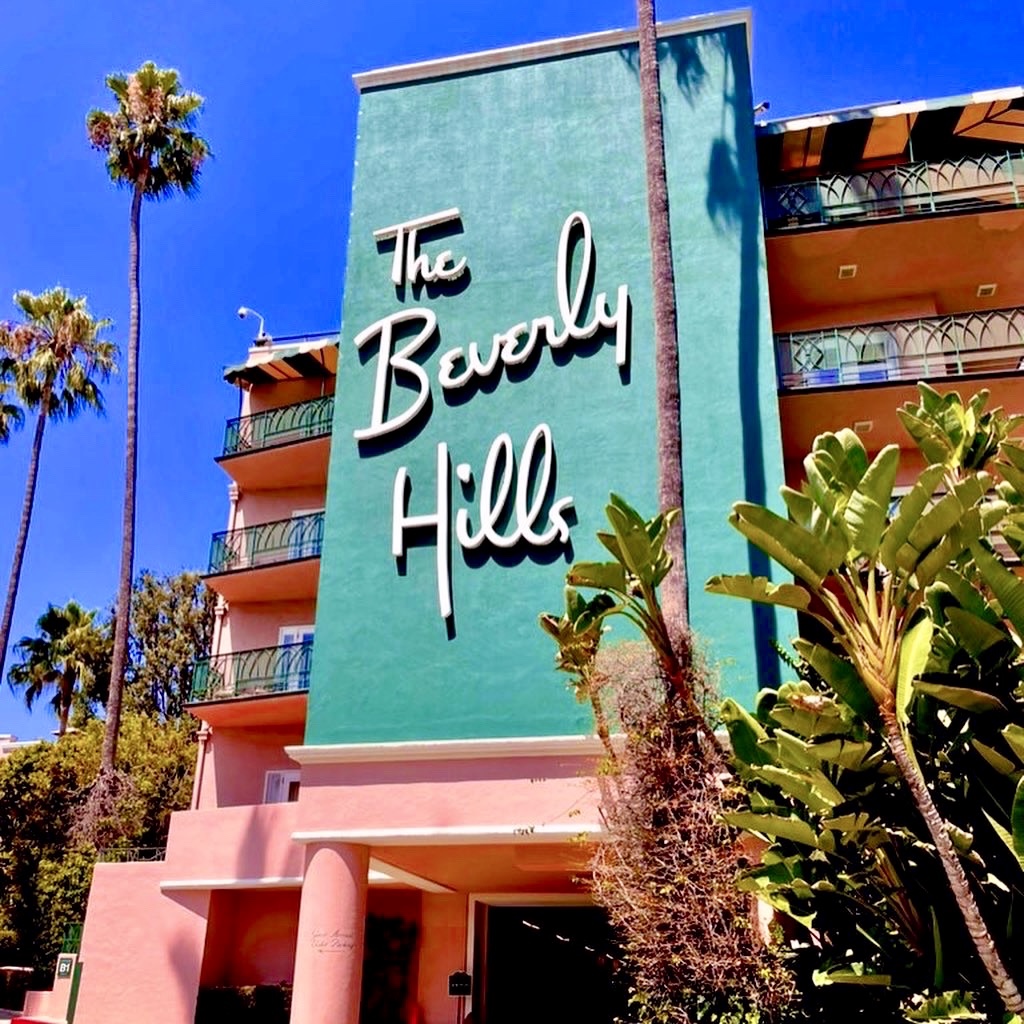
Los
Angeles is a city, a county, a tangle
of towns and a state of mind. It begins in the
San Gabriel Valley just west of
the El Cajon Pass and ends at the beach cities
along the Pacific Coast Highway.
In between are almost 5,000 square miles of
municipalities (88 in all), along
with the biggest spaghetti bowl of freeways in
America. Hidden among them are
all sorts of good places to eat, but getting
to them will always be a
challenge, in more ways than one.
But up to the challenge we were, so drive
there we did to check out the food scene. This
time, though, we weren't in
search of the best new places. This time we were
big game hunting—bagging the
ultimate prey like Hemingway on a bender, led by
a local food guide, and armed
with credit cards instead of shotguns. It was
epic eating of a particular SoCal
sort, punctuated by meals both highbrow and low.
We covered a lot of territory
in four days and here is the tale.
Polo
Lounge
Beverly
Hills Hotel
9641 Sunset Boulevard
Beverly Hills
310-887-2777
It doesn't get more old
school than The
Beverly Hills Hotel, perched on a hill
above Sunset Boulevard, looming over
swimming pools and movie stars like an edifice
of pink excess. The BHH has been
in more movies and dreams than one can count,
and its Polo Lounge serves
as a de facto commissary for big shots of the
movie producer ilk. (These days,
you're more likely to be rubbing shoulders with
FOMO Instagrammers and
bachelorette partiers than Swifty Lazar, but
such is the century we live in.)
While it is still possible to be seduced by the
prospect of running into B-list
actors and Eurotrash, we came for the food, and
maybe a little 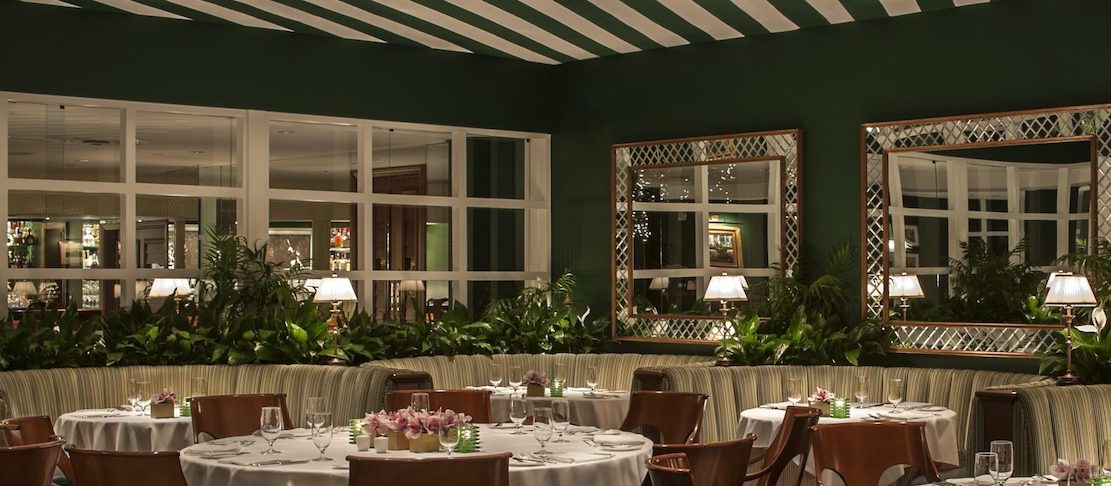 of the glamour
that this place still wears like a faded fur on
Norma Desmond.
of the glamour
that this place still wears like a faded fur on
Norma Desmond.
What we found was a lot more spruced up
than we recall from 20 years ago. Now a part of
the Dorchester Collection, its
mega-rich owners cannot be accused of letting it
go to seed. Things were
polished to a fare thee well, and the bathroom
fixtures are now more Louis
Quinze than Louis B. Mayer, with carpet so plush
you could sleep on it. There
is also lots of obsequious head-bowing as you
stroll through the joint, and
food artfully presented but un-challenging to
the palate. There's nothing
particularly interesting on the card, just the
standardized menu fare that gets
hustled out of hotel kitchens from Long Beach to
Long Island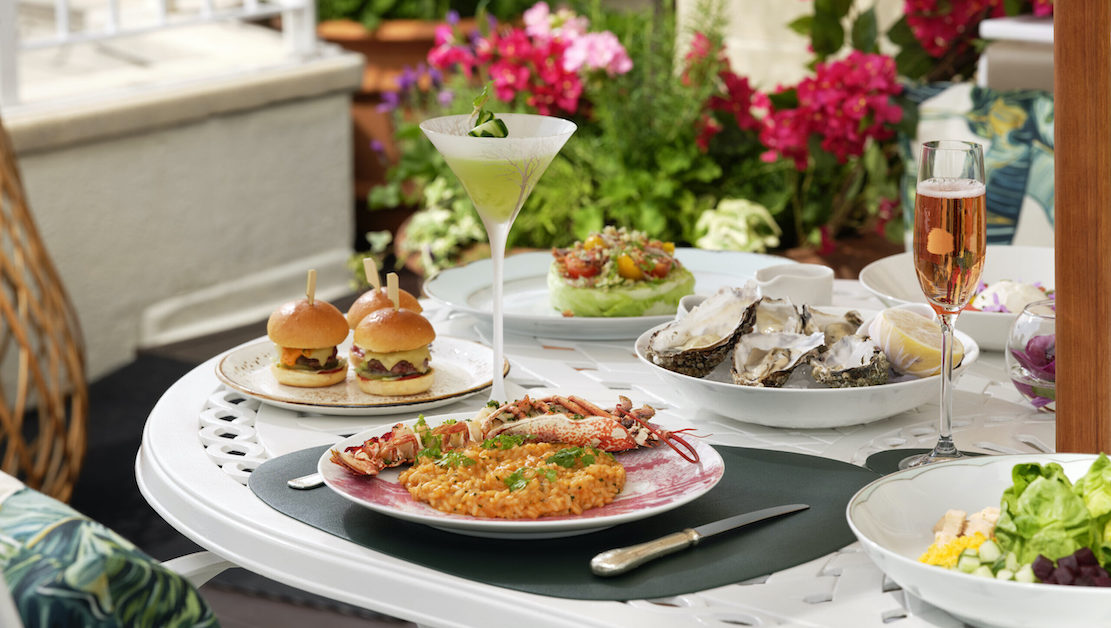 —here
made with
better groceries than most. You will eat well,
but you won't be so distracted
by the food that you can't spend most of your
meal searching for someone
famous—which is, after all, the whole point of
this place.
—here
made with
better groceries than most. You will eat well,
but you won't be so distracted
by the food that you can't spend most of your
meal searching for someone
famous—which is, after all, the whole point of
this place.
Worthy menu items included some
beautifully fresh California sea bass; a
substantial steak; excellent steak
tartare; a mammoth double-decker club sandwich,
and a not-over-priced wine
list. On the down side: prices are astronomic
and service metronomic, for the
privilege of paying $32 for a Cobb salad, and 42
bucks for fish tacos, you also
get waiters who barely look at you.
The Damage:
Lunch
with a few drinks or modest wine will run around
$100 per person.
CHEZ JAY
1657
Ocean Avenue
Santa Monica
310-395-1741
The great thing about Chez
Jay is,
it never got the snooty L.A. memo. Here, the
absence of attitude is as
refreshing 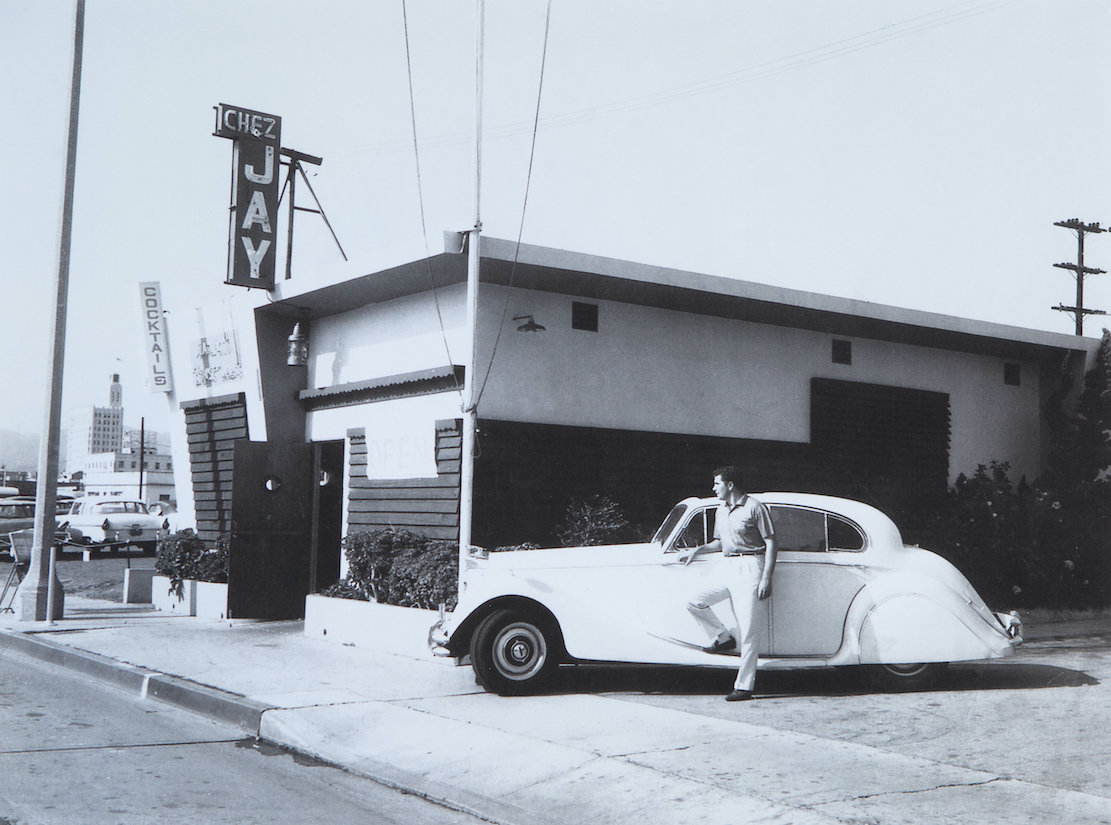 as the salty
breeze coming off the Pacific. Even when you
roll in
slightly inebriated, late at night with the
kitchen about to close, it feels
like you've staggered (literally) into an old
friend who is happy to see you.
as the salty
breeze coming off the Pacific. Even when you
roll in
slightly inebriated, late at night with the
kitchen about to close, it feels
like you've staggered (literally) into an old
friend who is happy to see you.
This down-market, laid back louche-ness
has been drawing us to this lovable dive for
thirty years. Only a stone's throw
from the Santa Monica Pier, the place used to be
filled with drunks and
fisherman (not to mention drunk fishermen) and
smelled like Coppertone mixed
with bait. The smell is  gone, but the boozers
remain. This is a good thing.
There is a quiet, scruffy alcoholism to Chez Jay
that provides the perfect
antidote to its upscale neighbors. "Every guy
who ever played Tarzan used
to hang out there," says writer/director James
Orr, and you can still feel
their presence every time some worn-out fellow
with a weather-beaten tan and a
floppy hat walks in.
gone, but the boozers
remain. This is a good thing.
There is a quiet, scruffy alcoholism to Chez Jay
that provides the perfect
antidote to its upscale neighbors. "Every guy
who ever played Tarzan used
to hang out there," says writer/director James
Orr, and you can still feel
their presence every time some worn-out fellow
with a weather-beaten tan and a
floppy hat walks in.
What you'll find at CJ is the opposite of
hoity-toity: a smiling welcome (whether you're a
has-been actor or not),
strong, well-made cocktails and an old-timey
"steaks, seafood, chops"
menu with some surprisingly tasty fare. Skip the
so-so steaks and head for the
garlic shrimp or sand dabs. And tip your sassy
waitress well: she's honed the
skill of reading people into a fine art.
If there's a better way to bring eating
Los Angeles into sharp relief than lunch at the
Polo Lounge and dinner at Chez
Jay, we haven't found it.
The Damage:
About $60
pp. at dinner.
n/naka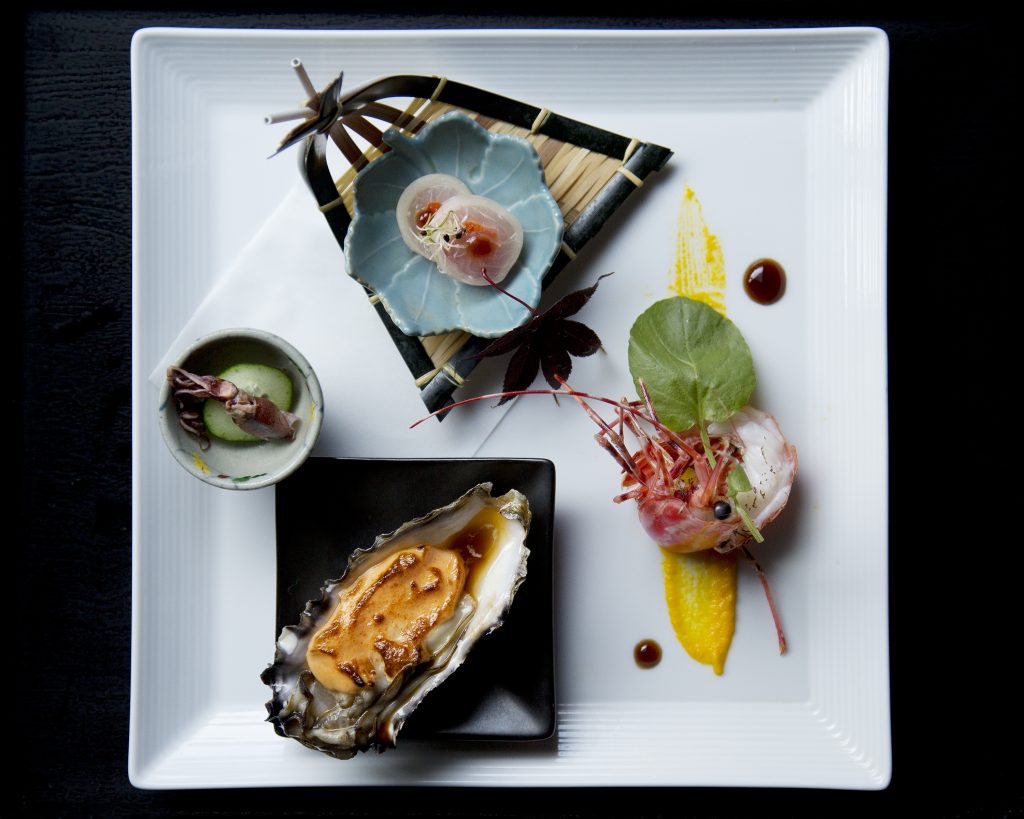
3455
Overland Avenue
Los Angeles
310-836-6252
Scoring
a reservation at n/naka
takes the patience of Job and the perseverance
of Sisyphus. I have neither, but
do have friends with connections, so in we
strolled to the toughest ticket in
Los Angeles—a small house on a corner of a
commercial street containing a
30-seat restaurant, a multi-course
kaiseki meal and a bill that would choke
a horse.
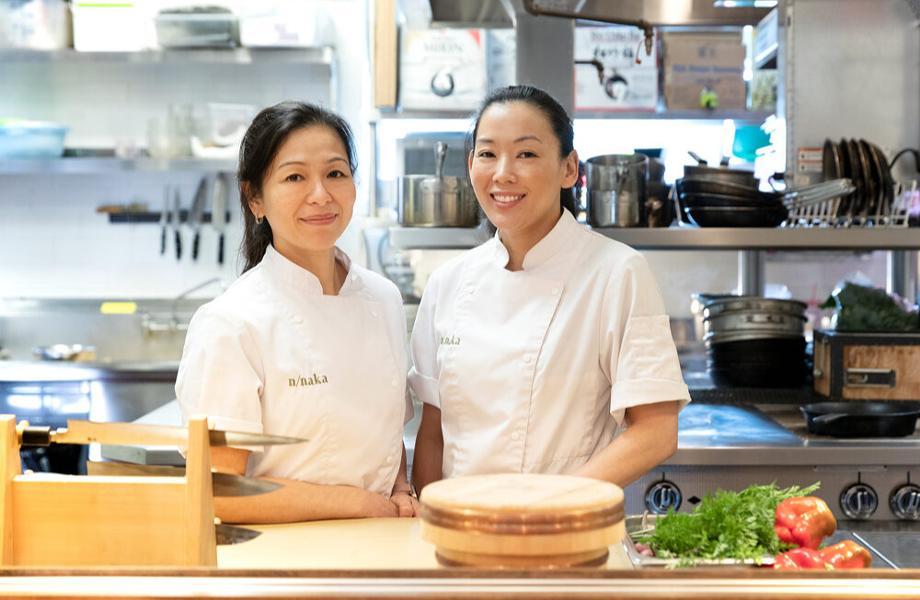 Having
appeared on the first season of
Netflix's Chef's Table made getting a ticket to
n/naka harder to come by than a
backstage pass at the Oscars. Fawning,
persistent press has sealed its fate as
one of those places that has become a cultural
touchstone. You no longer come
to n/naka just to eat; you come to embrace it as
a status symbol. As with the
French Laundry in Yountville, CA, , the food
(good as it is) has become beside
the point.
Having
appeared on the first season of
Netflix's Chef's Table made getting a ticket to
n/naka harder to come by than a
backstage pass at the Oscars. Fawning,
persistent press has sealed its fate as
one of those places that has become a cultural
touchstone. You no longer come
to n/naka just to eat; you come to embrace it as
a status symbol. As with the
French Laundry in Yountville, CA, , the food
(good as it is) has become beside
the point.
Despite the hype, chefs Carole
Iida-Nakayama and Niki
Nakayama
have found their perfect niche: a casual
California-inflected Japanese kaiseki
restaurant that pushes all the right buttons and
offers the best seafood/sushi/produce
the Southland has to offer. Where n/n excels is
in unforced elegance. The
restaurant itself is simple, bordering on the
austere, but look closely and you
see exquisite details, in the plates, the table,
the seating and the food. They
don't miss any of their marks. Service is as
smooth as the inside of an oyster
shell, and informative without being intrusive.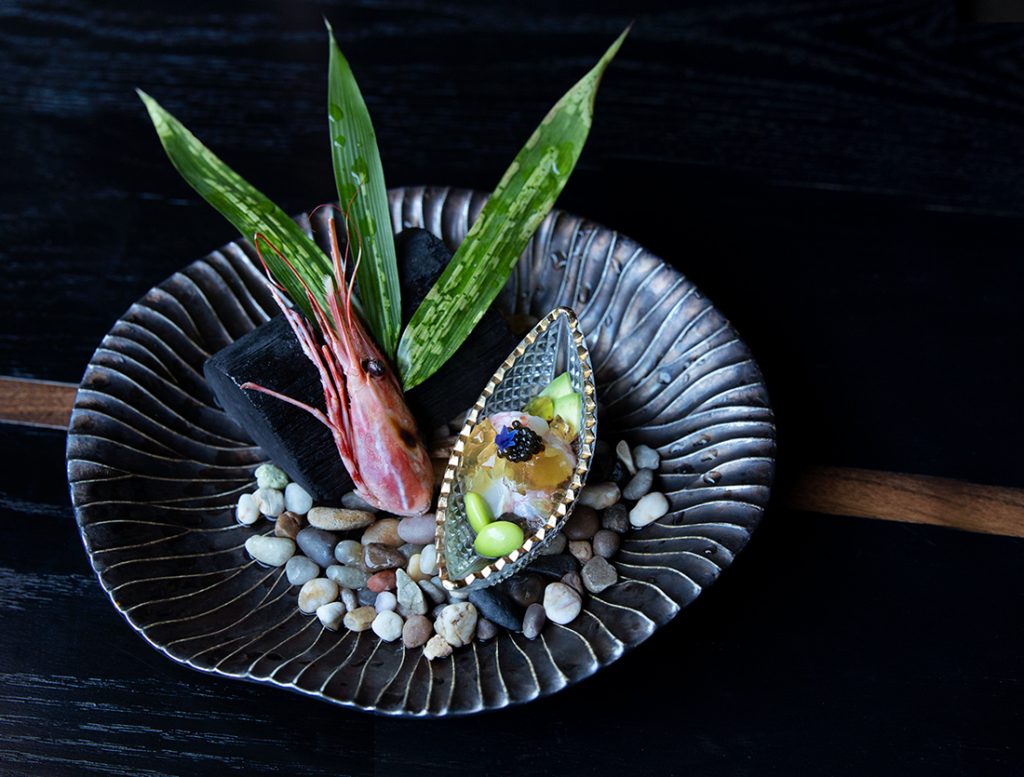
The sake and wine lists are short and
superb. The food is one eye-popping course after
another, almost effortlessly
served with succinct explanations and
instructions. There's an old joke about
every waiter in L.A, being a wannabe actor, so
the boss says, "Why don't
you try acting like a good waiter for a change."
No one's acting here; the
service is as good as it gets.
The
point of kaiseki is not as much to wow you
with a single dish as to soothe
your soul with a parade of bite-sized,
ultra-fresh delights, plucked at the
peak of deliciousness. It actually started out
as a few small savory bites
served to blunt the effects of strong green tea
during a sadō
(Japanese tea ceremony) but has
morphed into its own thing. Both here and across
the Pacific, "kaiseki"
now denotes the height of
Japanese epicureanism—a fixed price omakase
tasting menu representing the pinnacle of a
chef's skill—hyper-seasonal, and
full of symbolism (both obvious and
inscrutable), edible and otherwise.
Your twelve courses aim for each station
on the kaiseki
cross: Sakizuke,
Zensai, Owan,
Yakimono,
etc., and you begin
with a Sakizuke
of Hokkaido uni so
fresh it practically sparkles. Slippery-slick,
orange-tan and luminescent, it
enveloped a carrot coconut ice and was topped
with a dollop of trout eggs,
every element announcing the chef's skill at
combining disparate ingredients
into a whole greater than the sum of its parts.
This is high-wire cooking without a net,
and every bite has to be in
perfect balance with what came before, which it
was in the Zensai course
(assortment of small bites), showcasing the
chef's repertoire, then on to a
“Modern Zukuri"
course
(raw fish cut from live seafood), usually served
whole) of the kind of freshness you
only find within a few miles of an ocean.
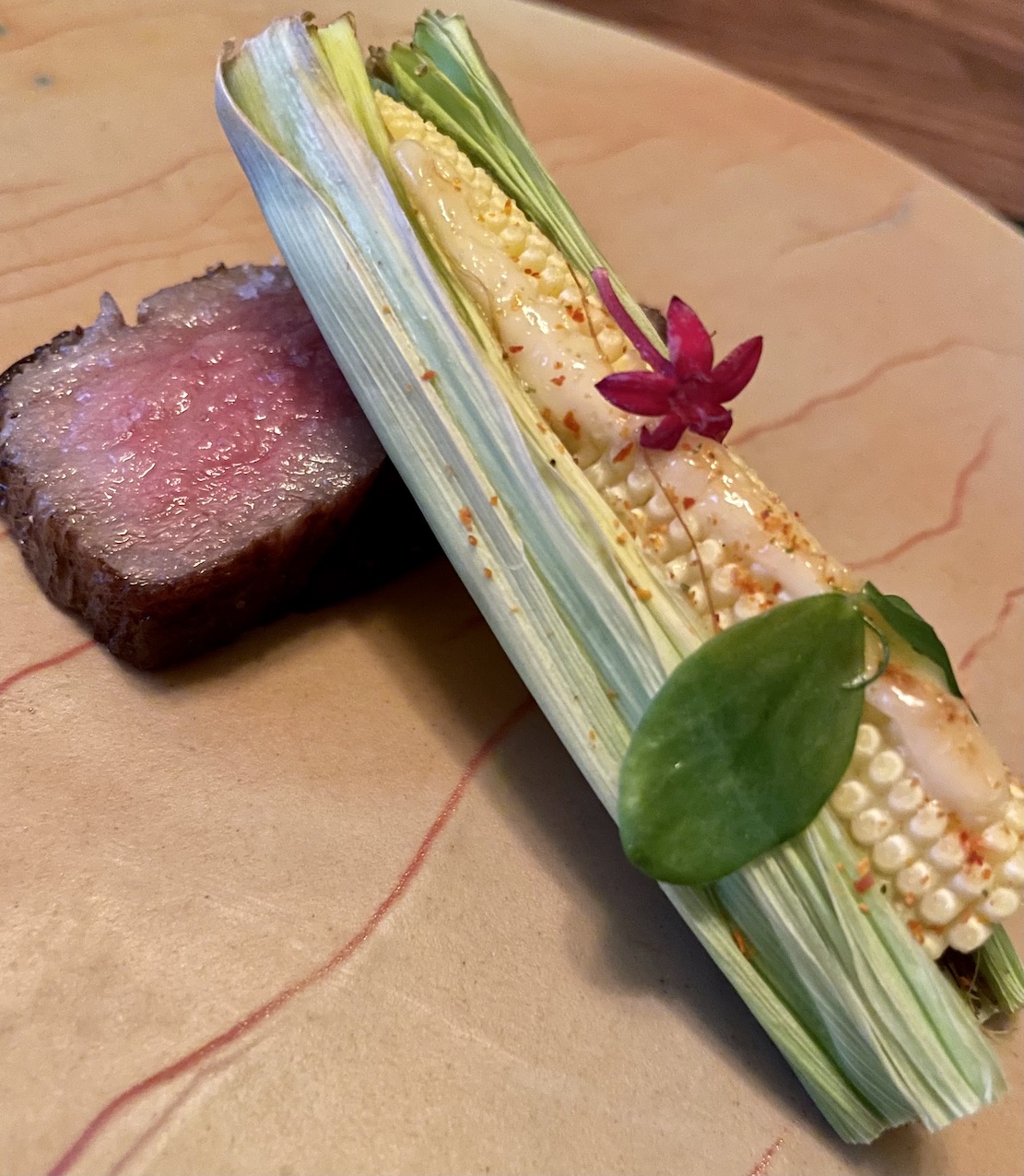 From there your meal proceeds through an
Owan
(soup course), with dashi
so bracing we could've
slurped it all night long. One course leads
seamlessly into another: after the Tai
(sea bream) soup comes twin ribbons
of sashimi, followed by grilled sea trout, and
then the star of the show: a Mushimono
of a peeled, poached tomato
wrapped around lobster, floating atop fennel
mochi croutons in a tomato broth—
gorgeous, complex food somehow retaining its
elemental, simple dignity—the best
evocation of summer on a plate we can remember.
From there your meal proceeds through an
Owan
(soup course), with dashi
so bracing we could've
slurped it all night long. One course leads
seamlessly into another: after the Tai
(sea bream) soup comes twin ribbons
of sashimi, followed by grilled sea trout, and
then the star of the show: a Mushimono
of a peeled, poached tomato
wrapped around lobster, floating atop fennel
mochi croutons in a tomato broth—
gorgeous, complex food somehow retaining its
elemental, simple dignity—the best
evocation of summer on a plate we can remember.
A couple
of things I didn't
"get" on the menu: some weird jelly of
cactus leaves, cucumbers
and chia seeds as the Sunomono
course—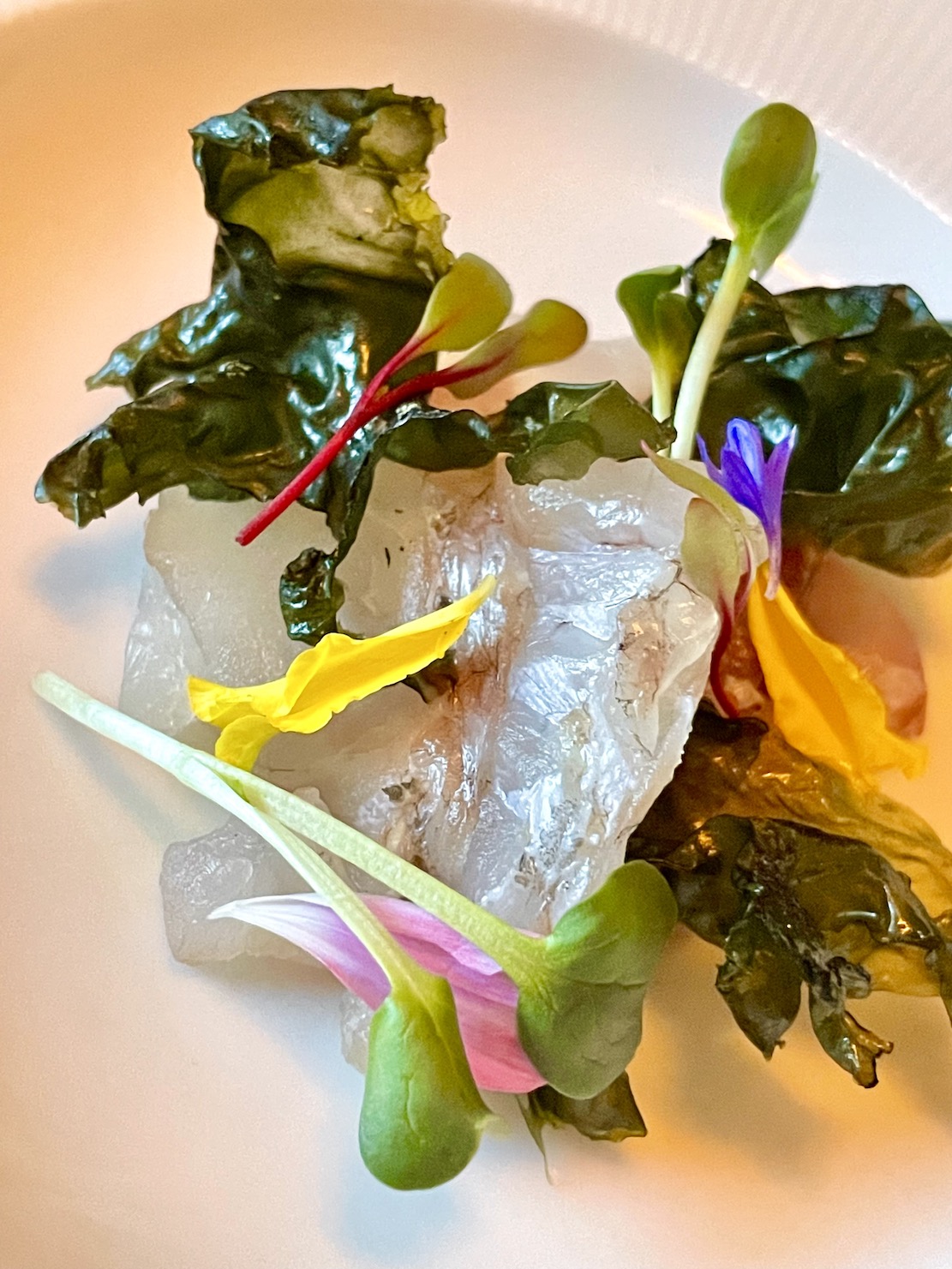 usually a
tart, refreshing salad. This one could compete
with okra in
the slimy foods Olympics. Ending the meal with Nigirizushi (after the A-5 Mizyazaki
wagyu course) was likewise odd. That beef, and
the signature dish of spaghetti
with abalone and Burgundy summer truffles (ugh),
were also about as local and
seasonal as ski boots on a surf board, but these
were but tiny blips in an
otherwise extraordinary experience.
usually a
tart, refreshing salad. This one could compete
with okra in
the slimy foods Olympics. Ending the meal with Nigirizushi (after the A-5 Mizyazaki
wagyu course) was likewise odd. That beef, and
the signature dish of spaghetti
with abalone and Burgundy summer truffles (ugh),
were also about as local and
seasonal as ski boots on a surf board, but these
were but tiny blips in an
otherwise extraordinary experience.
I may have had it with western tasting
menus, but you'd have to be one jaded palate to
ever tire of a proper kaiseki
dinner. There are only a handful
of restaurants in America that can compete with
n/naka in delivering a meal of
such subtle refinement. I'm fairly certain there
isn't a better one in Southern
California when it comes to service.
The Damage:
$285 pp,
exclusive of tax, tip and beverages. Even modest
beverages will cause a meal
for two to easily reach $1,000.
❖❖❖
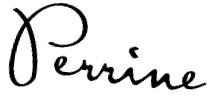
The Pierre
2 East 61st Street
212-980-8195
By John Mariani
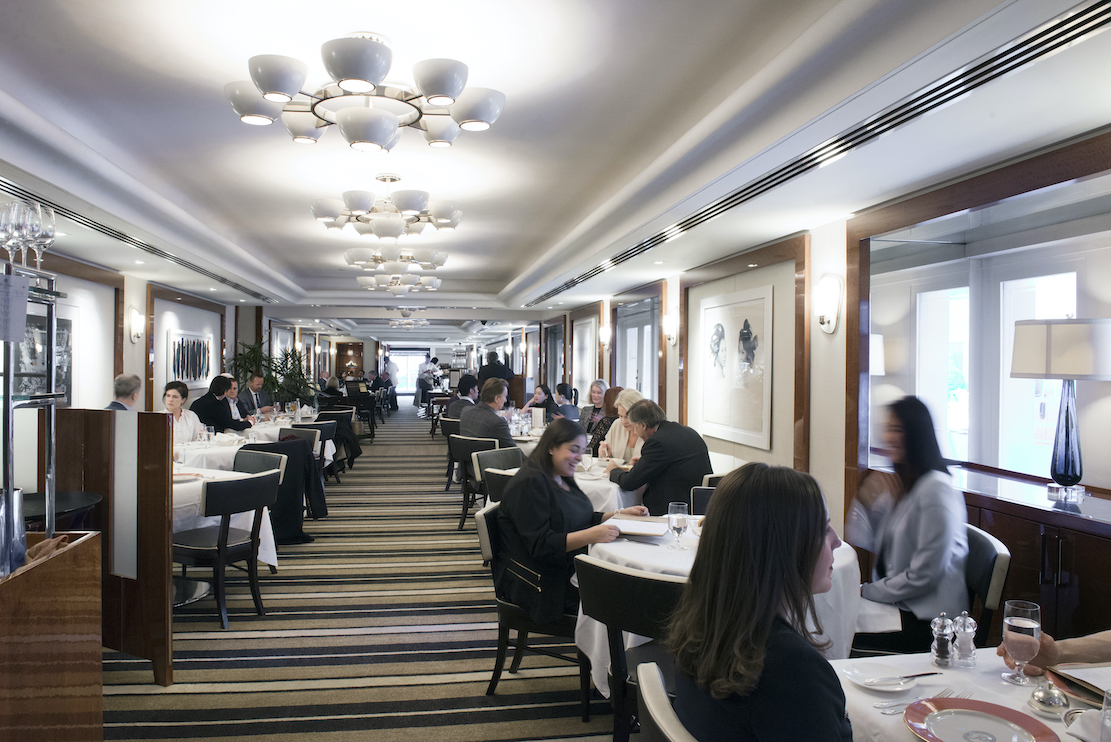
It’s
been a long time since the once
well-deserved onus of bad hotel restaurants
dissipated, not least because
modern hotels began seeing that their dining
rooms were not just necessary
conveniences but potential profit centers. The
change came when hotel
management saw the potential promotional value
in signing on celebrated chefs
who might transform them into destination
restaurants, even competing for
Michelin stars. Not many made 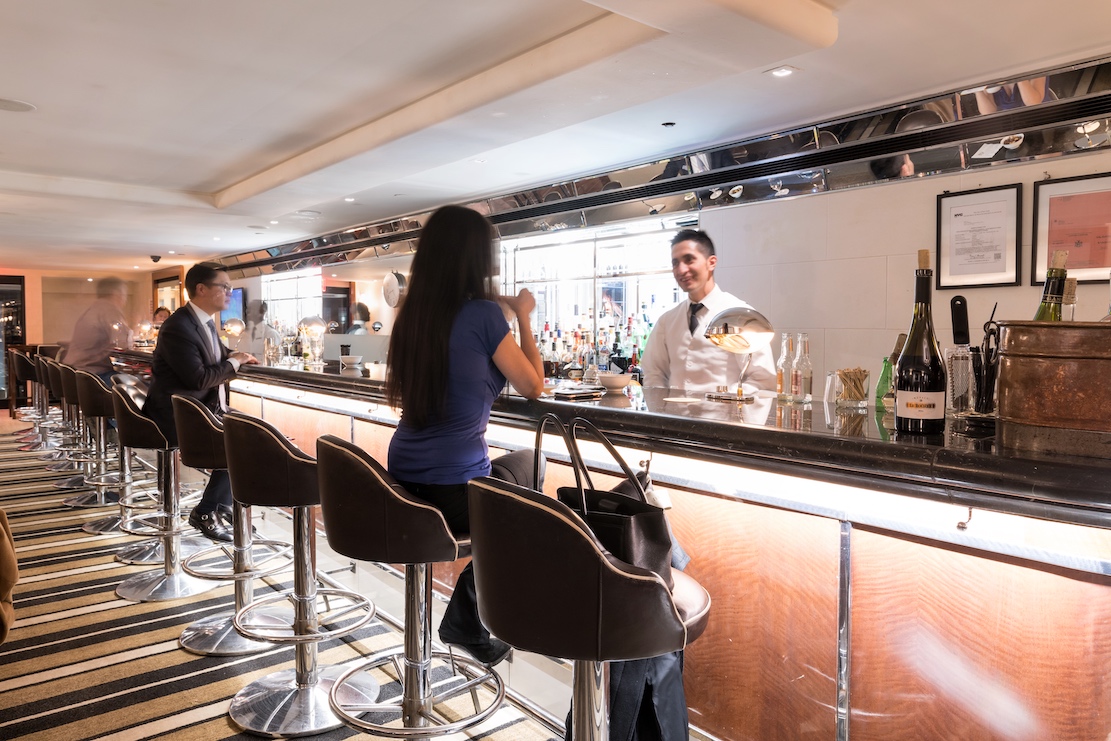 much
of a dent—Alain Ducasse flopped (twice) in
New York, as did Louis Outhier and Alain
Senderens (none of whom actually spent
much time cooking in New York), but Jean-Georges
Vongerichten, Will Guidara at
NoMad and Michael White at Ai Fiori all
succeeded admirably, and their
restaurants are considered among the city’s
finest. Problem is, rarely are these chefs ever
actually cooking at their restaurants.
much
of a dent—Alain Ducasse flopped (twice) in
New York, as did Louis Outhier and Alain
Senderens (none of whom actually spent
much time cooking in New York), but Jean-Georges
Vongerichten, Will Guidara at
NoMad and Michael White at Ai Fiori all
succeeded admirably, and their
restaurants are considered among the city’s
finest. Problem is, rarely are these chefs ever
actually cooking at their restaurants.
The high luxury Pierre Hotel, opened in
1930 on Fifth Avenue across from Central Park, and
its Café Pierre was one of
the top dining and club venues for decades up
until the 1960s, afterwards going
through various incarnations of disparate quality.
Now under the Taj Group
since 2005, efforts have been made to make its
dining room called Perrine into
a place that seems naturally to fit into anyone’s
idea of New York glamour
without pretension. 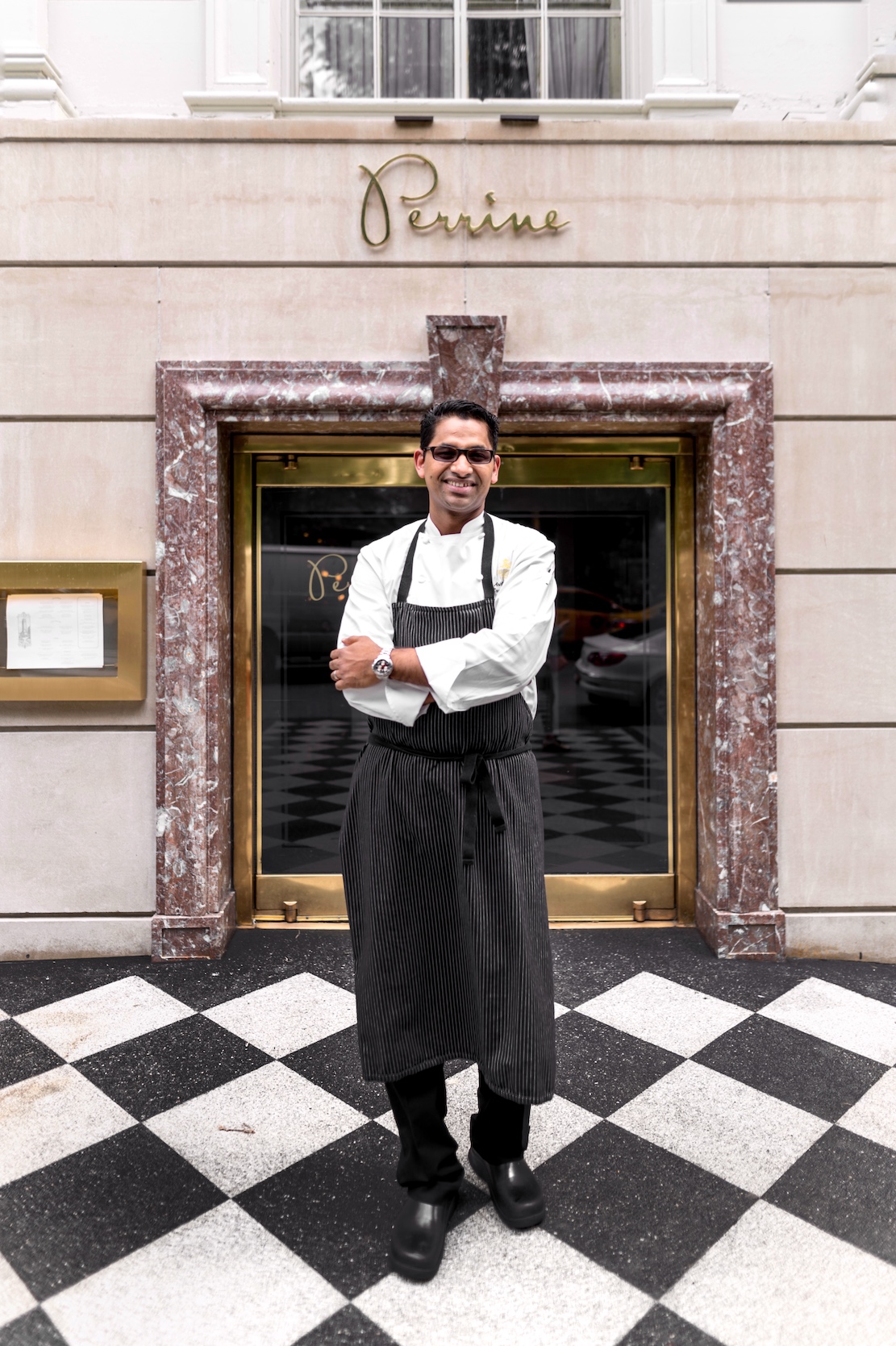
Under Executive Chef Ashfer Biju, born in
India and having long experience cooking in London
and Southeast Asia, Perrine
is not only one of the loveliest of the city’s
restaurants but, with its
largely modern American menu, proof that the
experience of rigorously trained
chefs like Biju pays off in the simplest dishes as
well as the most involved.
Unlike so many young chefs who concoct a few
signature dishes, chefs of Biju’s
background know how to make everything from a
deeply flavorful, clear consommé
to an impeccably roasted chicken. And they usually
have the hotel’s carte
blanche to buy the best quality ingredients.
A couple of years ago Biju added some
delectable Indian seasonings and dishes to his
menu, including steaming naan bread
I still remember, but those
are sadly gone. Some of the other dishes remain,
including a superb tuna
tartare with green beans, olives, basil and a
Dijon dressing ($26). It’s good
to see an old favorite of American cuisine back in
the form of crab imperial
toast (below) on rye bread with fresh
herbs, Gruyère and a pleasant modern inflection
of jalapeño ($25).
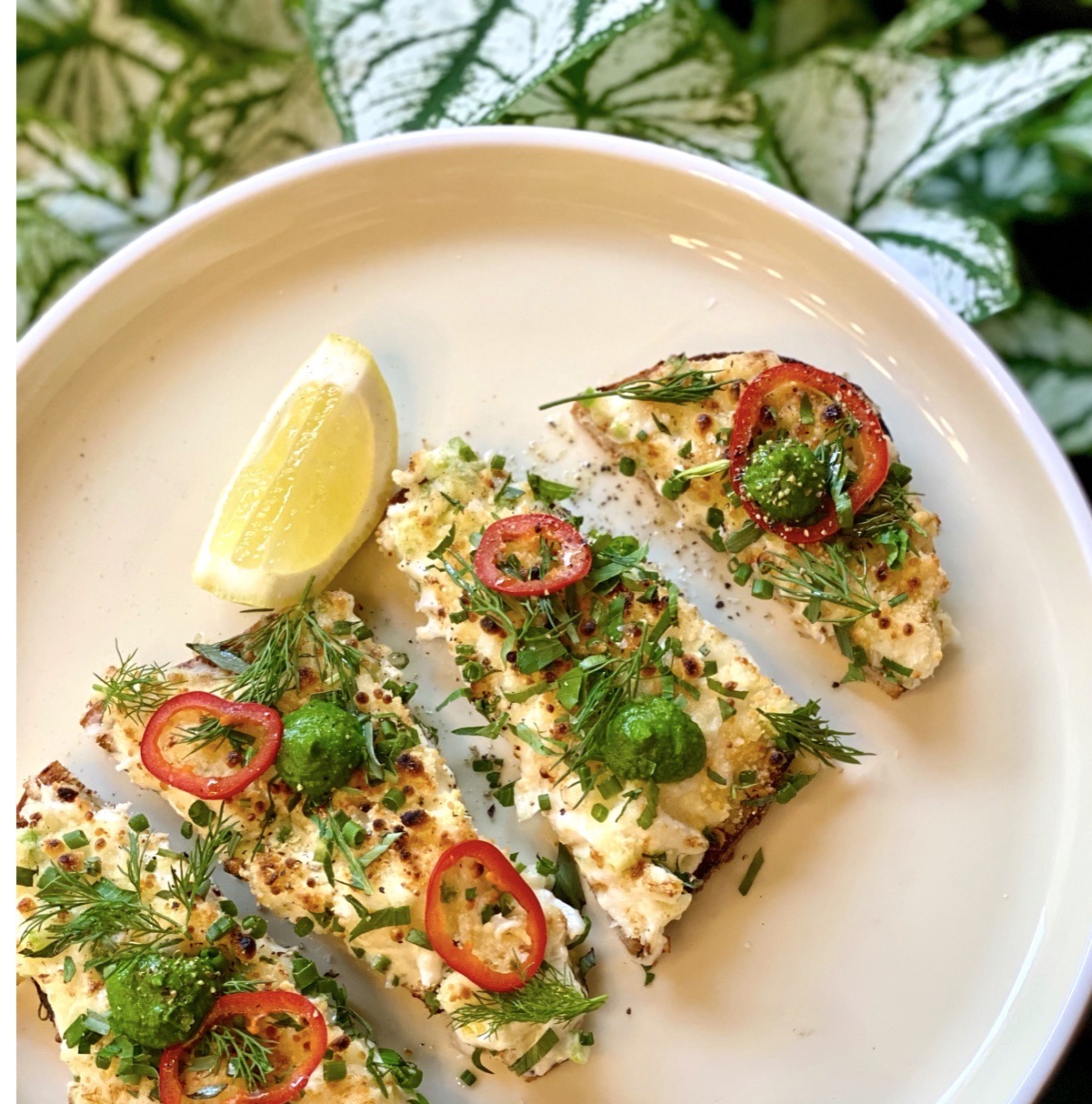 There are pasta dishes, as has become
requisite on every American menu these days,
including hand-cut cavatelli
in a hearty bolognese sauce
flecked with fresh oregano ($29) and linguine in a
white clam sauce, spiced
with tangy lemon, a good dose of garlic and
Serrano chilies, though it is pricey
at $35, especially since you don’t get an
abundance of clams.
There are pasta dishes, as has become
requisite on every American menu these days,
including hand-cut cavatelli
in a hearty bolognese sauce
flecked with fresh oregano ($29) and linguine in a
white clam sauce, spiced
with tangy lemon, a good dose of garlic and
Serrano chilies, though it is pricey
at $35, especially since you don’t get an
abundance of clams.
“Simply Prepared
Grilled or Roasted”
items are all expertly produced, focusing on the
quality of the ingredients
rather than flourishes. So, a good portion of
crisped lemon shrimp ($43)
brought out all the sweetness of the shrimp
balanced with the acidity of the
lemon. King salmon ($42) puts to shame all the
cheaper fishy  varieties so
often
served elsewhere; Biju accompanies it with du puy
lentils, spinach and a cream
lemon dill sauce to enhance the flavor. Roasted
branzino ($43) came at a
precise hot temperature, crisp on the skin, juicy
within, served with spiced
tomato, braised eggplant, kale and a caper
dressing that gives a hint of what
Biju used to do with this Indian dishes.
varieties so
often
served elsewhere; Biju accompanies it with du puy
lentils, spinach and a cream
lemon dill sauce to enhance the flavor. Roasted
branzino ($43) came at a
precise hot temperature, crisp on the skin, juicy
within, served with spiced
tomato, braised eggplant, kale and a caper
dressing that gives a hint of what
Biju used to do with this Indian dishes.
Also
recommended is the special of tender
shortribs ($54) in a wine-dark, complex reduction
(below).
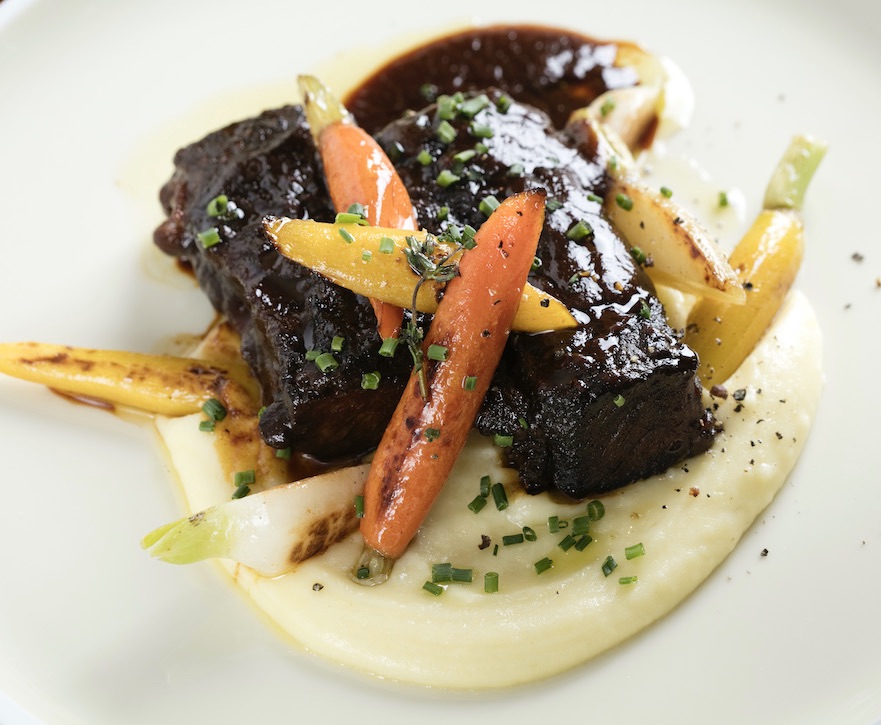 I
wouldn’t usually spend much time
talking about roast chicken, except that the
local, farm-raised variety at
Perrine is the start for a dish both simple and
sumptuous, with the bird itself
richly flavorful ($39). Biju
shows the
expertise I spoke of in rendering a perfectly
reduced, translucent white wine
sauce with pan juices along with pee wee potatoes
and mushrooms.
My delight was not in the complexity of a
dish I can find in myriad restaurants anywhere in
America; it was in the way
Perrine’s showed such care, from the choice of the
product to the careful
cooking of it, that makes it something memorable.
I’ve been thinking about that
bird for days afterwards.
I
wouldn’t usually spend much time
talking about roast chicken, except that the
local, farm-raised variety at
Perrine is the start for a dish both simple and
sumptuous, with the bird itself
richly flavorful ($39). Biju
shows the
expertise I spoke of in rendering a perfectly
reduced, translucent white wine
sauce with pan juices along with pee wee potatoes
and mushrooms.
My delight was not in the complexity of a
dish I can find in myriad restaurants anywhere in
America; it was in the way
Perrine’s showed such care, from the choice of the
product to the careful
cooking of it, that makes it something memorable.
I’ve been thinking about that
bird for days afterwards.
I regretted I did not order the Pierre
Burger ($29) this time out, if only for the pommes
frites that go with it, one of which I
plucked from a serving of a friend who
was eating at the bar. 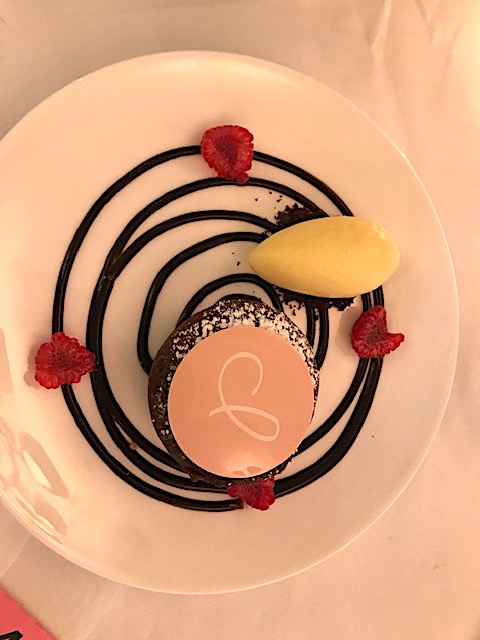 It was a
fabulous fry.
It was a
fabulous fry.
Desserts (all $12), too, show the mastery
of experience, especially in a hotel where
weddings and banquets demand an
endless production of them, not least a silky New
York-style cheesecake with
strawberries and whipped cream and a double
chocolate cake with wonderful crème
brûlée ice cream (right). There’s also a
trio of ice cream and sherbets ($11).
The wine list is not out to win trophies
for range but is instead designed to allow guests
to choose a good one by the
glass or bottle, with a sensible selection of
wines from
Europe, the Americas, and, for once, New York
State.
The staff at Perrine is, I’m told, new and
there were some awkward snafus and inattention on
a night when the room wasn’t
at all full. I trust that will improve with a
crack of the whip.
On
its looks and location alone, Perrine
is a glamorous spot, shiny, mirrored, sleek, with
thick white tablecloths,
excellent lighting, low background music (which
might be better chosen), wine
glasses for different varietals and a real Gotham
ambience of a kind you won’t
easily come across outside the city. (I do wish
they had retained the revolving door.) Part of it
is the Pierre’s pedigree: It’s
more Cole Porter than Woody Allen, more Audrey
Hepburn than Beyoncé, more Bill
Blass than Halston, and the food is a lesson in
how to cook the classics with
dedicated flair.
Perrine is open for breakfast,
lunch and dinner daily.
Note: NYC Health Dept. rules require both staff and guests 12 or older to show proof they have received at least one dose of a COVID-19 vaccine.
CAPONE’S
GOLD
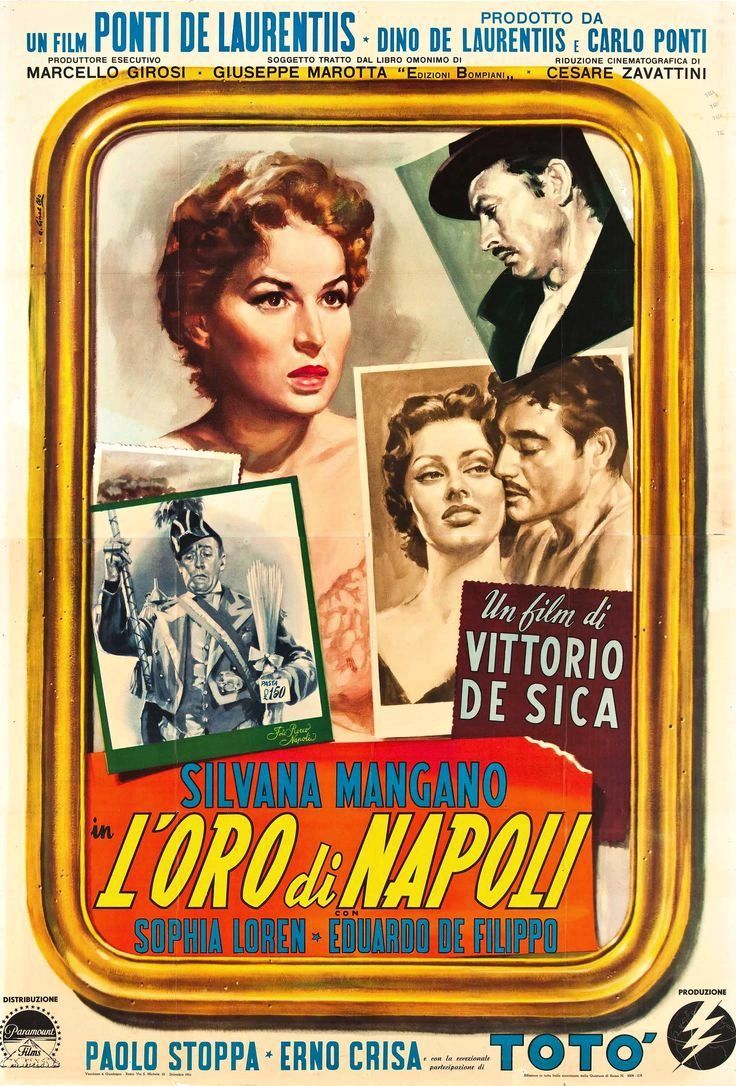
In
fact, David
had been in touch with special agent Giuseppe
Primerano, who also knew Frank
English, David’s F.B.I. contact in Washington.
The three of them had worked
together on the Gotti case, especially when it
came to the mobster’s laundering
drug money through Swiss banks.
Primerano held
the rank of tenente
colonnello
(lieutenant colonel) in GICO (Gruppo
d’investigazione sulla criminalità organizzata),
operating under the
Finance Police force. David had arranged a meeting
with Primerano the next day
at his headquarters on Via Cardinale
Guglielmo San Felice, near the Piazza
Dante.
But that
afternoon Katie and David decided to do a bit of
touring of the city, have
lunch, and put their heads together over a carafe
of wine.
“Hey, maybe we
should try that trattoria Frascella told us
about,” said Katie.
“You mean the
one he either did or did not eat in?” asked David.
“Unless you
have another suggestion.”
“There was a
place I used to go to with Giovanni near the
Garibaldi train station, called
Mimi. Very basic, lots of seafood and vegetables.”
“After the way
we’ve been eating, that sounds like a good choice.
Do we need a taxi?”
David glanced
at his watch. “Well, it’s 12:30 now, 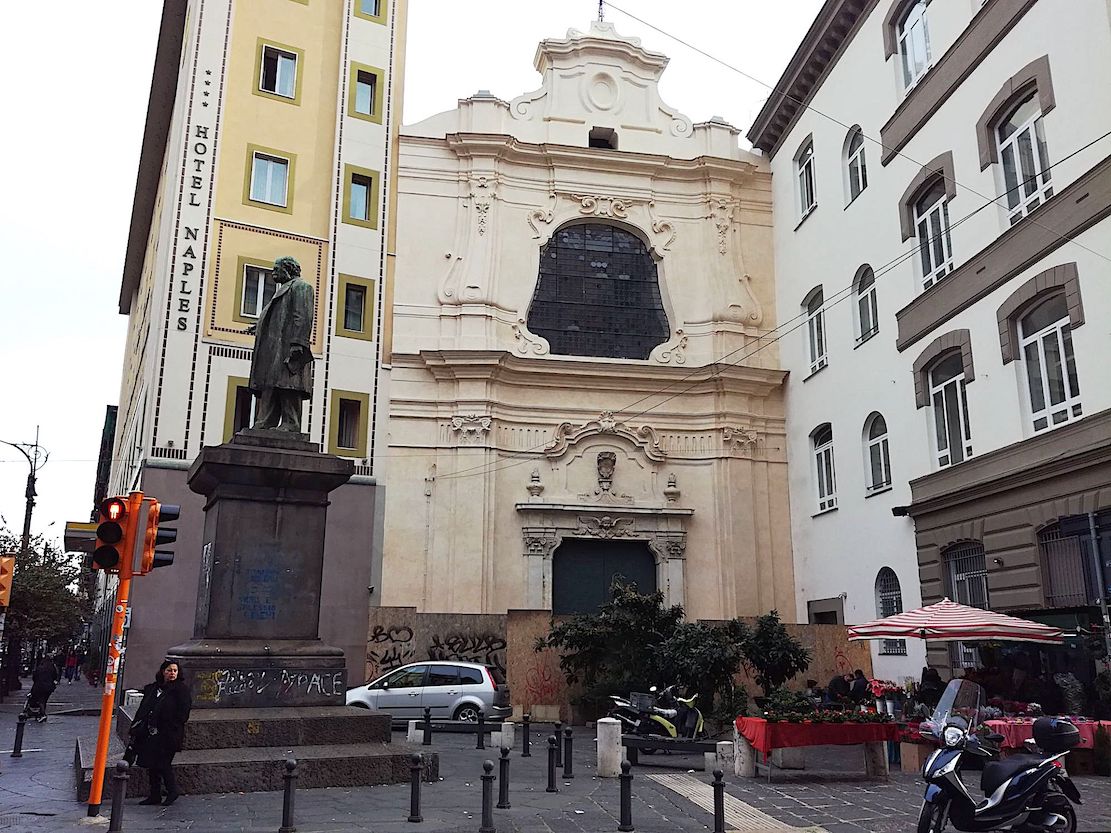 and
no one eats until one around here, so
we could walk it.
Be good for us.”
and
no one eats until one around here, so
we could walk it.
Be good for us.”
David located
the trattoria on the map, on Via Alfonso
d’Aragona, about a ten-minute walk, so
they took their time, passing the baroque 17th
century Basilica of Saint Peter,
whose location was said to be where St. Peter
himself preached while in Naples. The
couple had time to stop into the church,
which is wedged in by soot-darkened buildings and
parked cars everywhere.
“Somber
place,” said David, looking up at the round arches
and minimally decorated
dome.
“Of all the
churches in Naples,” said Katie, “this is not one
of the ones I’d choose to go
to Mass at. It’s so cold looking.”
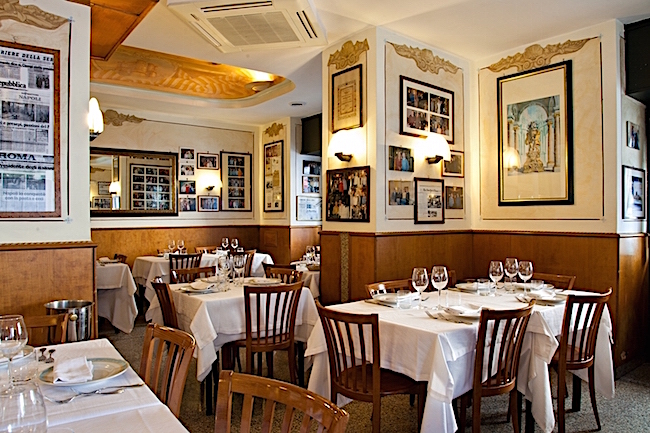 They
continued
on and found Mimi alla Ferovia (below)
almost empty at ten to one, but they were
welcomed by the owner and told to sit anywhere
they wished.
After ordering linguine alla Mimi, with assorted
seafood and tomato (below), and bucatini with
anchovies, capers and pepperoncini,
they helped themselves to
an antipasti
table groaning with
stuffed zucchini blossoms, fried eggplant, and
rustic bread with salumi and
cheeses. They ordered a bottle of Greco di Tufo
brought in an ice bucket.
They
continued
on and found Mimi alla Ferovia (below)
almost empty at ten to one, but they were
welcomed by the owner and told to sit anywhere
they wished.
After ordering linguine alla Mimi, with assorted
seafood and tomato (below), and bucatini with
anchovies, capers and pepperoncini,
they helped themselves to
an antipasti
table groaning with
stuffed zucchini blossoms, fried eggplant, and
rustic bread with salumi and
cheeses. They ordered a bottle of Greco di Tufo
brought in an ice bucket.
They spoke
about Naples over the antipasti,
then, with the pasta course, David was surprised
when Katie grinned and asked
him, “So, David, how’s your love life?”
David shook
his head, smiled, and said, “Not exactly roaring.
How’s yours?”
“I’m seeing a
guy. But I asked you first.”
David hated
hearing she was “seeing a guy,” but said, “Ever
since my wife died, I haven’t
been out and about much. I’m forty-eight years
old, I live pretty much as I
want to. I
don’t hang out at the
neighborhood bars.”
“You’re
forty-eight?” asked Katie. “I thought you were
younger. You’re
a good-looking guy. I bet there are a
lot of women who’d think you’d be a catch.”
“Not many I’m
interested in right now,” he said, feeling that
any hope of Katie warming to
him any further was pretty much gone after hearing
about her “seeing a guy.”
“So who’s the
guy?” he asked.
“Name’s Dan
Lucia.”
“Italian.
That’s good. What’s he do?”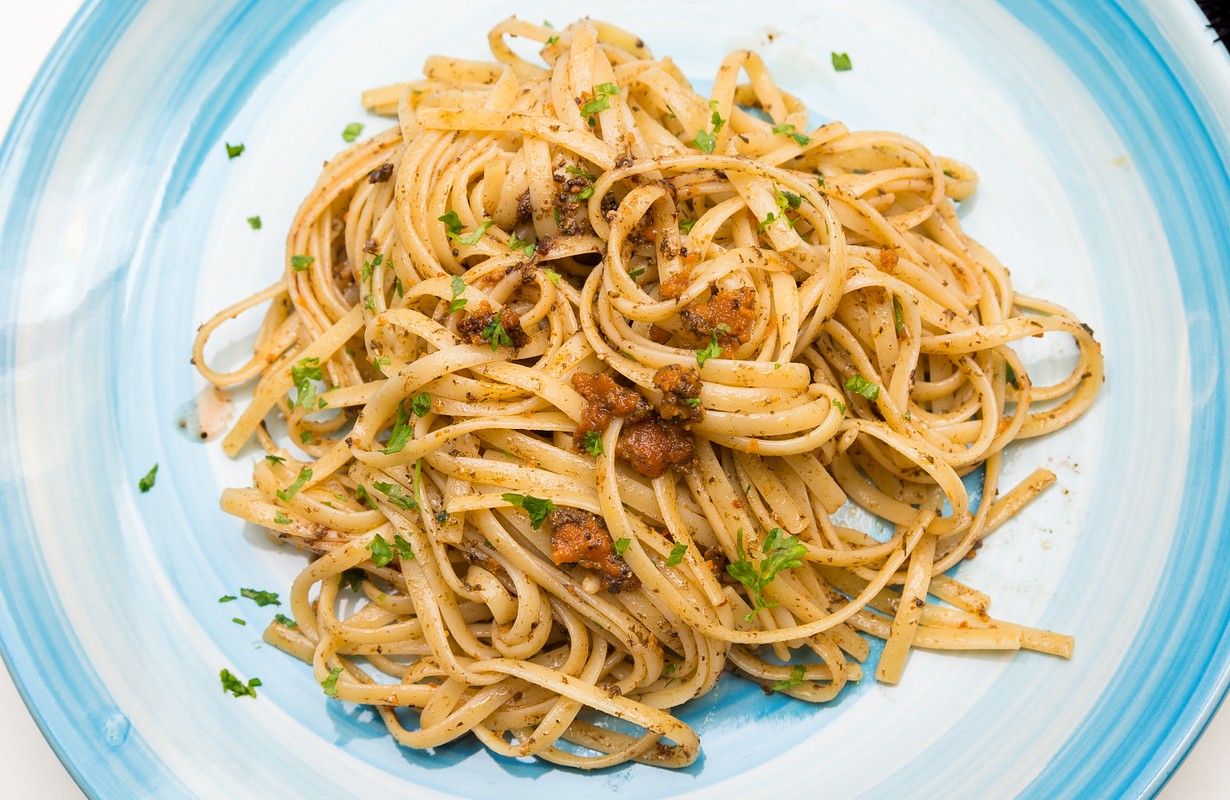
Katie wrinkled
her nose a little and said, “He’s . . . a . . .
lawyer.”
“Why am I not
surprised? Daddy’s girl.”
“I don’t know.
Maybe so. I just like Danny for what he is.”
“And what’s
that?”
Fluttering her
eyes, she said, “Oh, he likes long walks on the
beach and brings me daisies in
a coffee can and makes me laugh.”
“Seriously,
what do you like about the guy?”
“He’s a good
guy. Nice looking. Works hard, gets along with my
parents.”
David hated
hearing that, too. “So, how serious are you about
. . . Danny?”
“I don’t know
yet. See how it goes when we get back.
But right now I’m with you, drinking a nice
bottle of vino
and eating anchovies and don’t have
to worry about anchovy breath.”
David laughed,
but he got the picture.
*
*
*
The Finance
Police headquarters was located on a tree-lined
street in a large neo-classic
building with a tri-color flag of Italy and the
blue flag with stars of the
police. Inside,
guards in grey uniforms
with green berets passed Katie and David through
security to the second floor,
where Giuseppe Primerano, dark suit and tie,
greeted them warmly, his arms
outstretched.
He looked somewhat older
than David, olive complexion, graying hair.
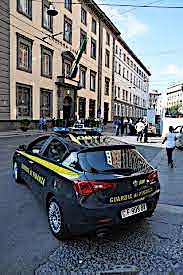 David
introduced
Katie, to whom the officer slightly bowed and then
ushered them into his
office, whose desk was piled with folders, as were
two chairs.
David
introduced
Katie, to whom the officer slightly bowed and then
ushered them into his
office, whose desk was piled with folders, as were
two chairs.
“Mi
dispiace, I’m sorry,” he said, “This
is a madhouse!”
“Looks about
the same as the last time I was here,” said David.
“Si,
and probably the same cases,
too. Things
move slowly in this
department.”
“But I hear
you’ve been pretty successful recently. Put some
of the top guys away.”
“We
investigate, we arrest them, they go to court two
years later, then it’s out of
my hands. I’m
like the exterminator you
call when your house is infested. The insects
usually come back.”
He picked up
the folders on the chairs and piled them on the
floor.
“Caffè?”
Katie and David
nodded, and Primerano hit a button on his phone
and ordered three espressos.
Katie took out her recorder and asked if it was
all right to use it. Primerano
waved his hands and said, “I’m sorry, no. But you
can take notes.”
“So, David,
how can I help you? You’re looking for Al Capone’s
gold and you think it’s here
in Naples. You know, there was a movie made by
Vittorio de Sica called Gold of
Naples?”
Both David and
Katie shrugged.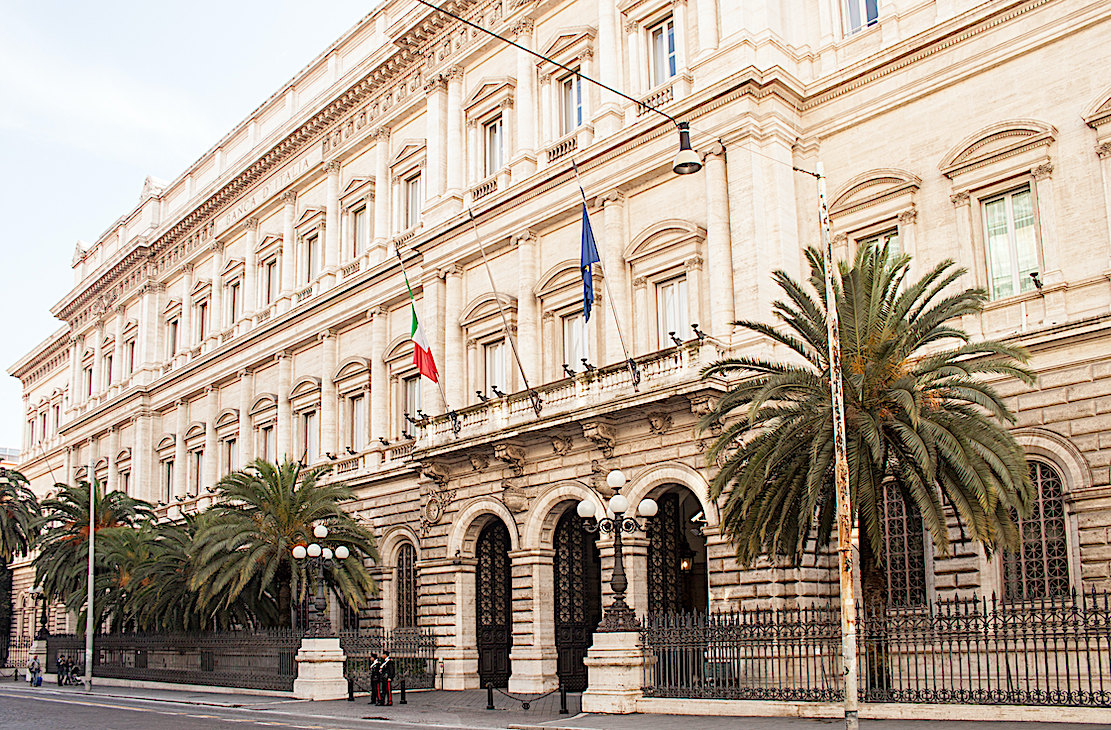
“Well, it has
nothing to do with our Mr. Capone,” said
Primerano.
“So,” said
David, “I think the gold is here somewhere in
Italy,” then began again the
whole story of what had led them to the lieutenant
colonel’s office, mentioning
their visit to Giovanni Lucadamo the day before.
“Molte
interessante,” said Primerano.
“You’ve told me things I didn’t know. Of
course, Al Capone is known to every Neapolitan,
though the current generation
has no interest in him. His reputation these days
is mezzo-e-mezzo: Half the oldtimers
respect him because his people
came from Campania, and the other half think he is
a black mark on our
region. So
many tourists they come to
Naples and want to know about Al Capone. Al
Capone! Where he was born, where he
lived. They
are so disappointed when
they’re told he wasn’t born here and never set
foot in Naples, although I’m
sure some of the tour guides make up stories to
the contrary.”
“So what have
you heard?” asked Katie. “It’s a fifty-year-old
case.”
“Allora,
I was never part of the case,
and it was closed as far as our office was
concerned sometime in the 1950s, I
think.”
“So there was
an open file on it in Italy?”
“Oh, yes, I
took it out for you. But it was only a part of a
much bigger investigation as
to what happened to all the gold that had been
stored away in Italian banks (above, right)
by
the Fascisti. You know
that Mussolini even begged Italians
abroad to send their gold to him.”
Katie and
David both said they knew women who’d donated
their wedding rings to Il Duce.
“It was an
amazing appeal,” said Primerano. “And in those
days, before the war, he really
did try to use it to fix the Italian economy,
which was terrible.
Mussolini’s support for Franco in the
Spanish
Civil War went very badly and was draining Italy’s
gold reserves.
So it would have been fantastic for him to
accept American bullion from the great Al Capone.”
© John Mariani, 201
❖❖❖
New Appellation Rules For
Spain's Cava Sparkling Wines
By John Mariani
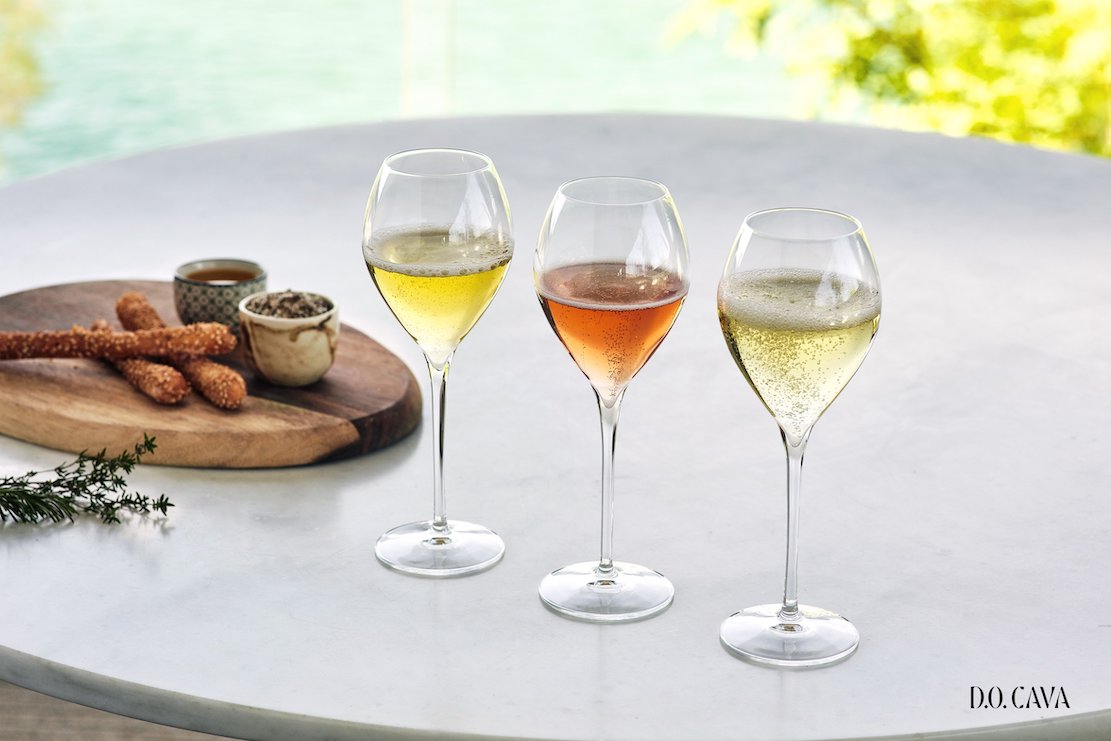
The
success of Spain's sparkling wines called cava has
required stricter oversight as to quality, which has
led to the formation of the Regulatory
Council of the CAVA Protected Designation of
Origin. Since September 2018,
Javier Pagés has presided over the organization, as
well as serving as the President of the Barcelona
Wine Week (BWW) international Spanish wine fair. I
interviewed him as to what the new regulations will
mean.
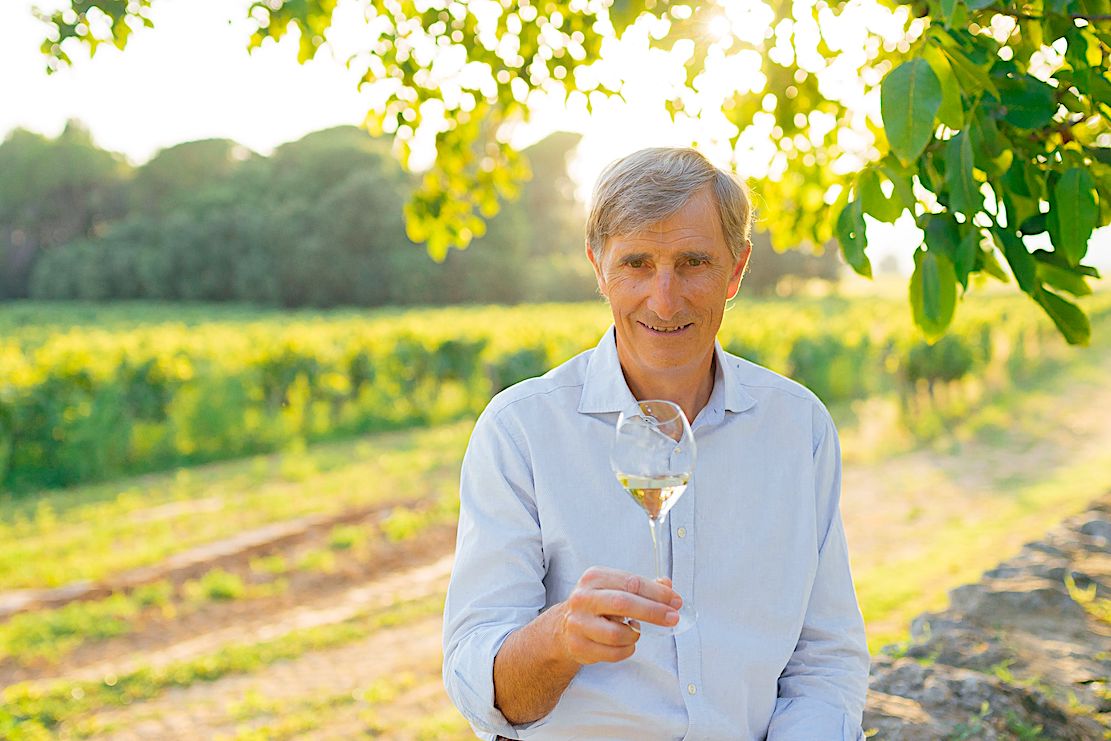
What is new about the zoning of
production area and why was this
done?
The
new
regulations aim to augment the quality
characteristics of Cava wines involving
all winegrowers and winemakers of the Designation of
Origin. We are committed
to maximum traceability and quality. It is the most
demanding regulation
globally for quality D.O. sparkling wines made using
the strict traditional
method. All of this places the D.O. Cava at the
forefront of quality sparkling
wine designations of origin.
Cavas aged more than nine months will now
be called Cava de Guarda, while those aged more
than 18 months will be
called Cava de Guarda
Superior. The Cavas de Guarda
Superior will be made with grapes from
vineyards registered in the
Regulatory Board’s specific Register of Guarda
Superior, which must meet the
following requirements: vines at least ten years
old, organic vines (5 years of
transition), vines with specific qualitative yields
of a maximum of 4.9
tons/acre, separate production (separate
traceability from the vineyard to the
bottle), production starting in January, proof of
the vintage on the label, and
organic product (5 years of transition).
The new regulations also require that the
production of Cavas de Guarda Superior, the
long-aging category that includes
Cavas Reserva (minimum 18 months of aging), Gran
Reserva (minimum 30 months of
aging), and Cavas de Paraje Calificado (from a
special plot and with a minimum
of 36 months of aging), will be 100% organic by
2025.
Moreover, the new zoning of the D.O. Cava
has been established on two levels, marked by
specific climatic, orographic,
historical, and cultural attributes that justify the
new plan and lend these
wines their unique identity. The following zones
have been defined: Comtats de
Barcelona, which encompasses the Cavas of the region
of Catalonia (with
sub-zones Valls d'Anoia-Foix; Serra de Mar; Conca
del Gaia; Serra de Prades and
Pla de Ponent), Ebro Valley (with sub-zones Alto
Ebro and Valle del Cierzo),
Viñedos de Almendralejo, and Levante (the definitive
nomenclature is still to
be confirmed). 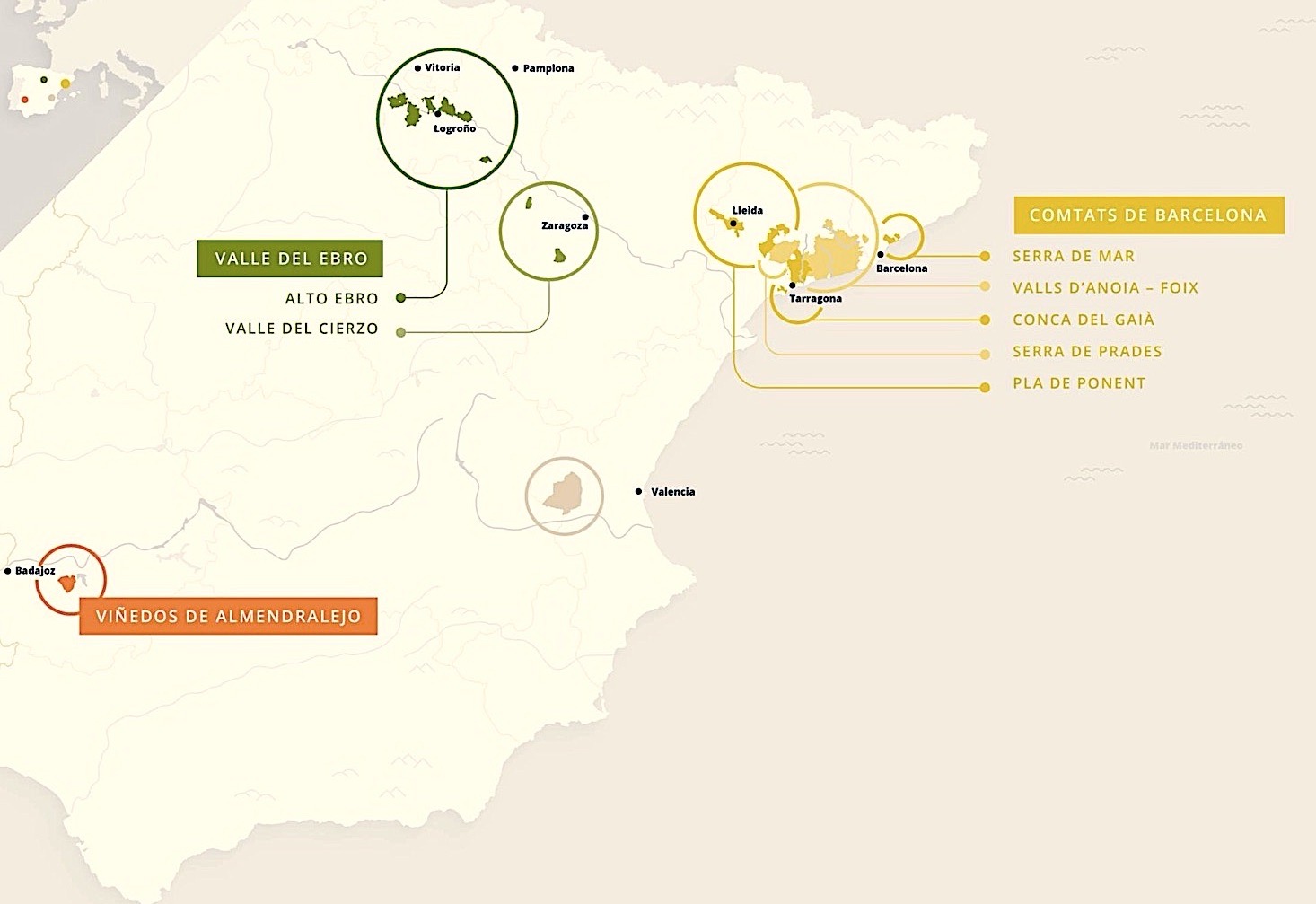 In
addition, the demanding new regulations allow the
voluntary
creation of an “Integral Producer” label for those
wineries that press and
vinify 100% of their products. This new historic
zoning and segmentation by
Cava D.O. will appear on the labels of the first
bottles in January 2022.
In
addition, the demanding new regulations allow the
voluntary
creation of an “Integral Producer” label for those
wineries that press and
vinify 100% of their products. This new historic
zoning and segmentation by
Cava D.O. will appear on the labels of the first
bottles in January 2022.
Cava really had soaring success over
the past 10 years not least
because it was quite inexpensive. But much of it
was not very good, just as
much Italian Prosecco is not very good. What
distinguishes a fine Cava from a
basic one?
The
ageing time is without
question crucial when we want to differentiate a
fine wine from the youngest
one. For Cava, the word basic doesn’t apply,
considering its minimum ageing is
nine months. Therefore, the comparison with Prosecco
is incorrect from the very
beginning, when we have two products with different
elaboration methods—we use the méthode champenois,
they do not—and
the investment associated with each is very
different. With Cava, the consumer gets access to a
wide range of
complexity in aromas and texture, while in Prosecco,
that´s not possible solely
because there´s no ageing time.
 Tell
me about the new molecular study.
Tell
me about the new molecular study.
François
Chartier is an
aromas specialist and is regarded internationally as
one of the pioneering
researchers in aromatic recipes and “molecular
harmonies,” or creating ideal
harmonies in food and wine pairings. He created a
discipline in 2002 which maps
out the aromatic molecules that give food and wine
their flavor. After
conducting in-depth research, the expert in aromas
and “Créateur d’Harmonies”
Chartier published a ground-breaking scientific
study on Cava.
Chartier demonstrates that Cava is the
best ally of gastronomy and pairs perfectly with an
infinity of flavors
worldwide. After carrying out general aromatic
profiles of the four different
categories of Cava (Traditional, Reserva, Gran
Reserva, and Paraje Calificado
Cava), Chartier analyzed the dominant molecules for
each category through the
aromatic science of “molecular harmonies.”
Chartier’s exhaustive research has
led to the identification of multiple ingredients
complementary to Cava and translated
into an infinity of recipes from around the world.
What material is available on the
Cava Academy website?
This
educational project
came about following the success of several
in-person sessions given in the
United States, United Kingdom, and Belgium. The new
Academy, available in three
languages (Spanish, Catalan and English), is a more
accessible training tool
designed to train professionals across various
industry sectors—sales,
distribution, wine tourism, and others. Throughout
the online course,
participants will become experts in all things
related to the quality of
Spanish sparkling wine, ranging from viticulture and
the production of Cava to
its classification and quality guarantees and
tasting and food pairings. The
curriculum offers audio-visual content, videos, and
interactive tests that make
the learning process enjoyable, intuitive, and
adaptable to the pace of each
student. Tastings are conducted by leading wine
professionals and Cava
ambassadors, including Pedro Ballesteros MW and
Ferran Centelles, in
educational video tutorials. Upon completing an exam
at the end of the course,
successful candidates will receive a Certified Cava Trainer
diploma and access the Cava Academy
Alumni community.
Once travel is
permitted, course graduates will be able to
participate in a 2- or 3-day visit
to the Cava region to experience winery visits as
well as master classes
focused on Cava’s gastronomic versatility. Students
who wish to take their Cava
studies one step further will have the opportunity
to present a thesis on a
choice of three subjects related to the sector
throughout the year. The title
of Cava Expert will be awarded to all those who
present their thesis in
compliance with the requirements, and the top-rated
work of the year will be recognized.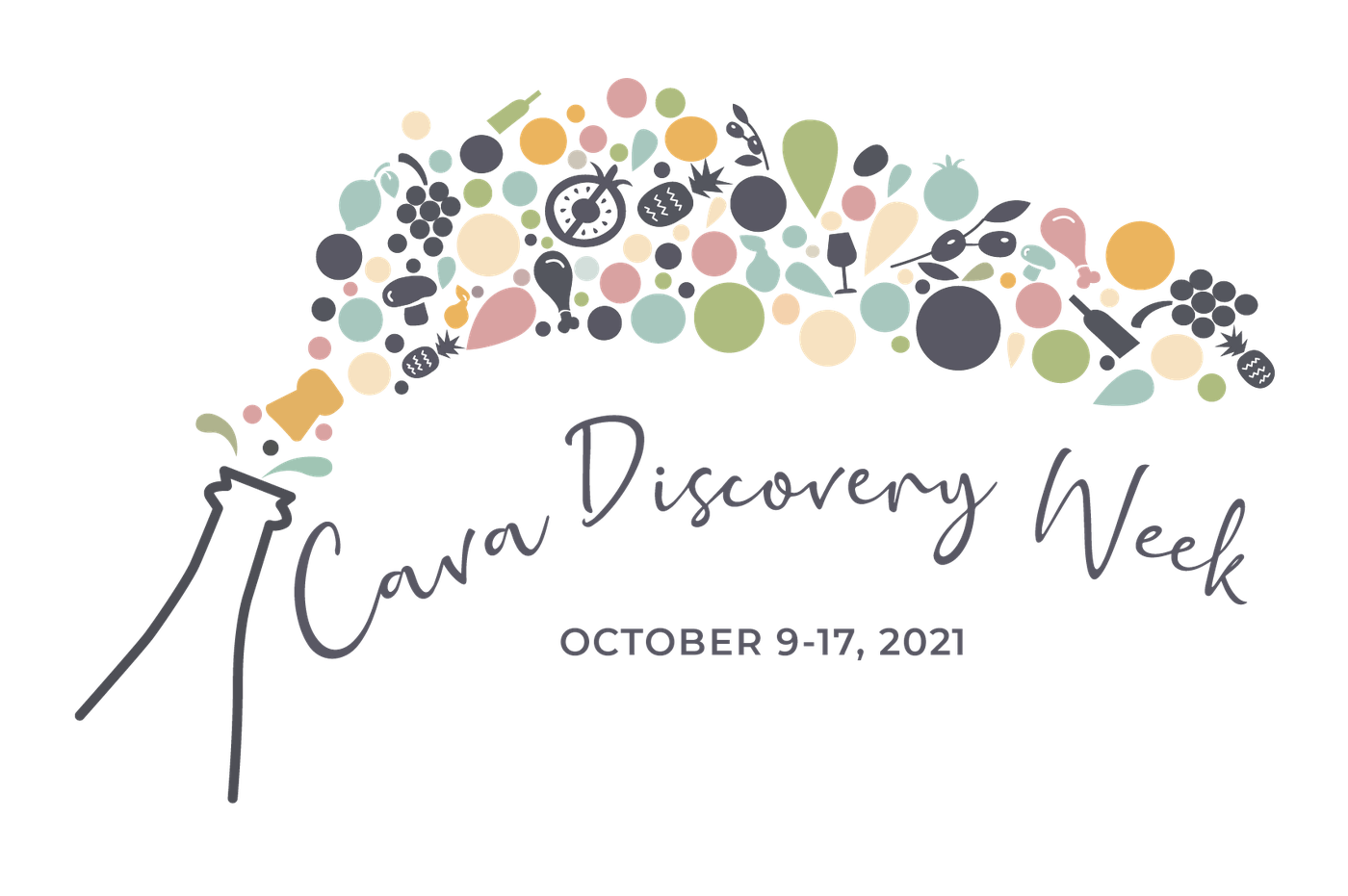
You just finished your “Wine Cava
Discovery Week.” How successful
was it and what plans do you have for the future?
Following
what has been a
very difficult time for on-premise establishments in
the U.S. and worldwide, we
felt privileged to partner with several fine dining
establishments in New York
City, including Yannick Benjamin’s new Contento,
José Andrés’s celebrated
Mercado Little Spain, and Francie, the newly awarded
Michelin-star Brooklyn
brasserie. The promotion was complemented by various
digital marketing
activations resulting in high levels of engagement
among sparkling wine lovers
around the U.S. This is an activity that we aim to
fine-tune and to grow in the
years to come.
Although Champagne producers would
like to deny it, is it not true
that Cava has become a real alternative sparkling
wine in Europe as well as in
the United States?
Cava is
unquestionably an excellent
alternative to Champagne, considering
it´s a unique opportunity for a consumer to
get a high-quality product
more affordable than champagne.
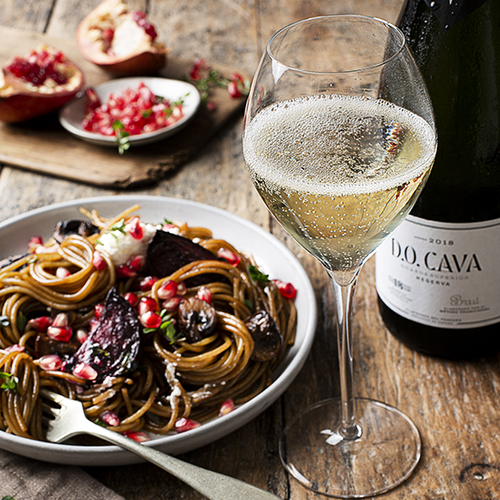 How
has global warming and other climate factors
affected the
production of Cava wines?
How
has global warming and other climate factors
affected the
production of Cava wines?
Global
warming has led to an
advance in harvest dates in order to maintain the
alcohol/acidity balance.
Is there a concern that some
producers may try to charge too much
for Cavas that have been very good buys up until
now?
The
aspiration to raise
prices is inevitable when you have an excellent
product, and that price should
communicate that level of excellence. Instead of a
concern, it is a great
opportunity for the producer.
What are the best foods that go well
with Cava?
Thanks
to the different
types and styles of this unique drink, you can
always find a wide range of
options, whether for lunch, dinner, an aperitif, or
simply enjoying your moment
with a glass of great bubbles. From Thanksgiving
turkey, Christmas bonbons,
chicken causa limeña, prawn and squid ink baos
to a vegan chocolate and tofu cake, Cava's
versatility pairs perfectly with
classic recipes worldwide.
Are all Spanish sparkling wines
called Cava, or are there others
under other names?
Despite
other commercial
brands, Cava is the only official designation of a
Spanish sparkling wine
following all quality standards regulated by an
official Regulatory Board with
the power to control and guarantee the quality
level, which only a Designation
of Origin can deliver.
❖❖❖
JUST ONE MORE THING TO WORRY ABOUT
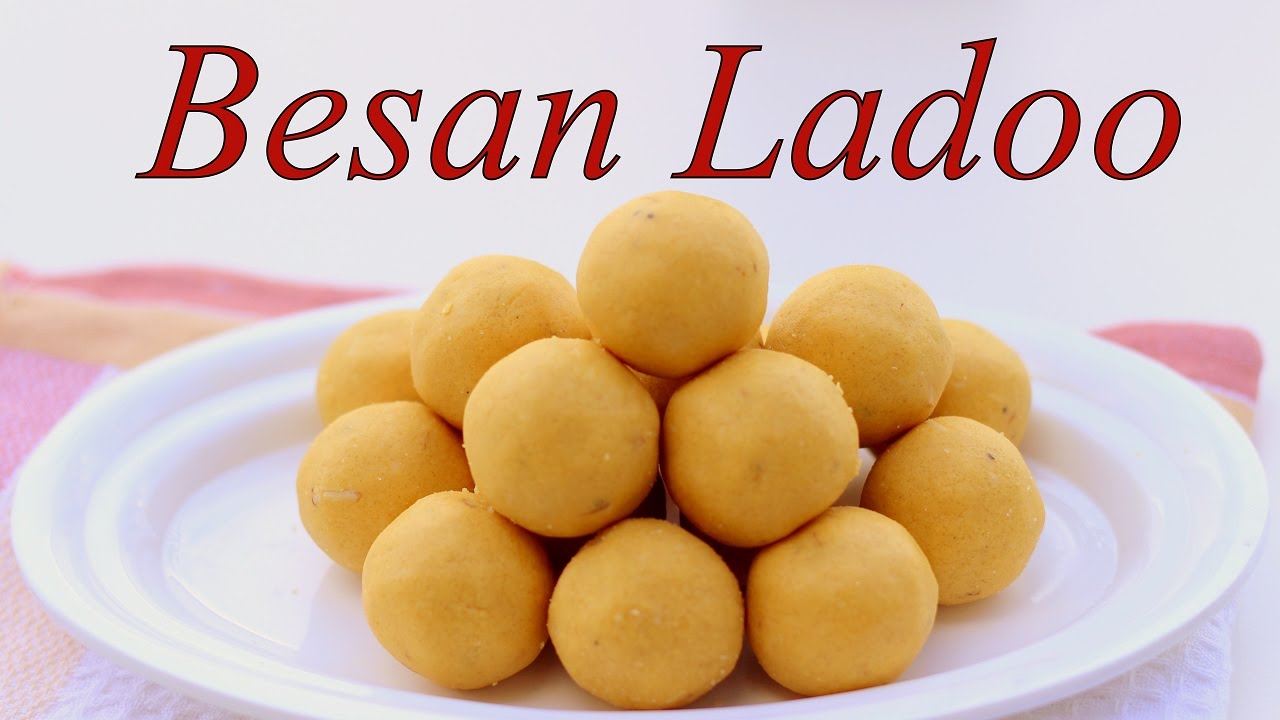
"Is your Besan adulterated with paralysis-causing Khesari flour?"—Times of India (11/1/21)
Any of John Mariani's books below may be ordered from amazon.com.
 The Hound in Heaven
(21st Century Lion Books) is a novella, and
for anyone who loves dogs, Christmas, romance,
inspiration, even the supernatural, I hope you'll find
this to be a treasured favorite. The story
concerns how, after a New England teacher, his wife and
their two daughters adopt a stray puppy found in their
barn in northern Maine, their lives seem full of promise.
But when tragedy strikes, their wonderful dog Lazarus and
the spirit of Christmas are the only things that may bring
his master back from the edge of despair.
The Hound in Heaven
(21st Century Lion Books) is a novella, and
for anyone who loves dogs, Christmas, romance,
inspiration, even the supernatural, I hope you'll find
this to be a treasured favorite. The story
concerns how, after a New England teacher, his wife and
their two daughters adopt a stray puppy found in their
barn in northern Maine, their lives seem full of promise.
But when tragedy strikes, their wonderful dog Lazarus and
the spirit of Christmas are the only things that may bring
his master back from the edge of despair. WATCH THE VIDEO!
“What a huge surprise turn this story took! I was completely stunned! I truly enjoyed this book and its message.” – Actress Ali MacGraw
“He had me at Page One. The amount of heart, human insight, soul searching, and deft literary strength that John Mariani pours into this airtight novella is vertigo-inducing. Perhaps ‘wow’ would be the best comment.” – James Dalessandro, author of Bohemian Heart and 1906.
“John Mariani’s Hound in Heaven starts with a well-painted portrayal of an American family, along with the requisite dog. A surprise event flips the action of the novel and captures us for a voyage leading to a hopeful and heart-warming message. A page turning, one sitting read, it’s the perfect antidote for the winter and promotion of holiday celebration.” – Ann Pearlman, author of The Christmas Cookie Club and A Gift for my Sister.
“John Mariani’s concise, achingly beautiful novella pulls a literary rabbit out of a hat – a mash-up of the cosmic and the intimate, the tragic and the heart-warming – a Christmas tale for all ages, and all faiths. Read it to your children, read it to yourself… but read it. Early and often. Highly recommended.” – Jay Bonansinga, New York Times bestselling author of Pinkerton’s War, The Sinking of The Eastland, and The Walking Dead: The Road To Woodbury.
“Amazing things happen when you open your heart to an animal. The Hound in Heaven delivers a powerful story of healing that is forged in the spiritual relationship between a man and his best friend. The book brings a message of hope that can enrich our images of family, love, and loss.” – Dr. Barbara Royal, author of The Royal Treatment.
 |
The Encyclopedia of American Food and Drink by John F. Mariani (Bloomsbury USA, $35) Modesty forbids me to praise my own new book, but let me proudly say that it is an extensive revision of the 4th edition that appeared more than a decade ago, before locavores, molecular cuisine, modernist cuisine, the Food Network and so much more, now included. Word origins have been completely updated, as have per capita consumption and production stats. Most important, for the first time since publication in the 1980s, the book includes more than 100 biographies of Americans who have changed the way we cook, eat and drink -- from Fannie Farmer and Julia Child to Robert Mondavi and Thomas Keller. "This book is amazing! It has entries for everything from `abalone' to `zwieback,' plus more than 500 recipes for classic American dishes and drinks."--Devra First, The Boston Globe. "Much needed in any kitchen library."--Bon Appetit. |
"Eating Italian will never be the same after reading John Mariani's entertaining and savory gastronomical history of the cuisine of Italy and how it won over appetites worldwide. . . . This book is such a tasteful narrative that it will literally make you hungry for Italian food and arouse your appetite for gastronomical history."--Don Oldenburg, USA Today. "Italian
restaurants--some good, some glitzy--far
outnumber their French rivals. Many of
these establishments are zestfully described
in How Italian Food Conquered the World, an
entertaining and fact-filled chronicle by
food-and-wine correspondent John F.
Mariani."--Aram Bakshian Jr., Wall Street
Journal.
"Equal parts
history, sociology, gastronomy, and just
plain fun, How Italian Food Conquered the
World tells the captivating and delicious
story of the (let's face it) everybody's
favorite cuisine with clarity, verve and
more than one surprise."--Colman Andrews,
editorial director of The Daily
Meal.com. "A fantastic and fascinating
read, covering everything from the influence
of Venice's spice trade to the impact of
Italian immigrants in America and the
evolution of alta cucina. This book will
serve as a terrific resource to anyone
interested in the real story of Italian
food."--Mary Ann Esposito, host of PBS-TV's
Ciao
Italia. "John Mariani has written the
definitive history of how Italians won their
way into our hearts, minds, and
stomachs. It's a story of pleasure over
pomp and taste over technique."--Danny Meyer,
owner of NYC restaurants Union Square
Cafe, The Modern, and Maialino.
|
 |
 |
 |
 |
 |
 |
 Everett Potter's Travel Report:
Everett Potter's Travel Report: 
 Eating Las Vegas
JOHN CURTAS has been covering the Las Vegas
food and restaurant scene since 1995. He is
the co-author of EATING LAS VEGAS – The 50
Essential Restaurants (as well as
the author of the Eating Las Vegas web site: www.eatinglasvegas.
He can also be seen every Friday morning as
the “resident foodie” for Wake Up With the
Wagners on KSNV TV (NBC) Channel 3 in
Las Vegas.
Eating Las Vegas
JOHN CURTAS has been covering the Las Vegas
food and restaurant scene since 1995. He is
the co-author of EATING LAS VEGAS – The 50
Essential Restaurants (as well as
the author of the Eating Las Vegas web site: www.eatinglasvegas.
He can also be seen every Friday morning as
the “resident foodie” for Wake Up With the
Wagners on KSNV TV (NBC) Channel 3 in
Las Vegas.
MARIANI'S VIRTUAL GOURMET
NEWSLETTER is published weekly. Publisher: John Mariani. Editor: Walter Bagley. Contributing Writers: Christopher
Mariani, Misha Mariani, John A. Curtas, Gerry Dawes, Geoff Kalish.
Contributing
Photographer: Galina Dargery. Technical
Advisor: Gerry
McLoughlin.
If you wish to subscribe to this
newsletter, please click here: http://www.johnmariani.com/subscribe/index.html
© copyright John Mariani 2021


